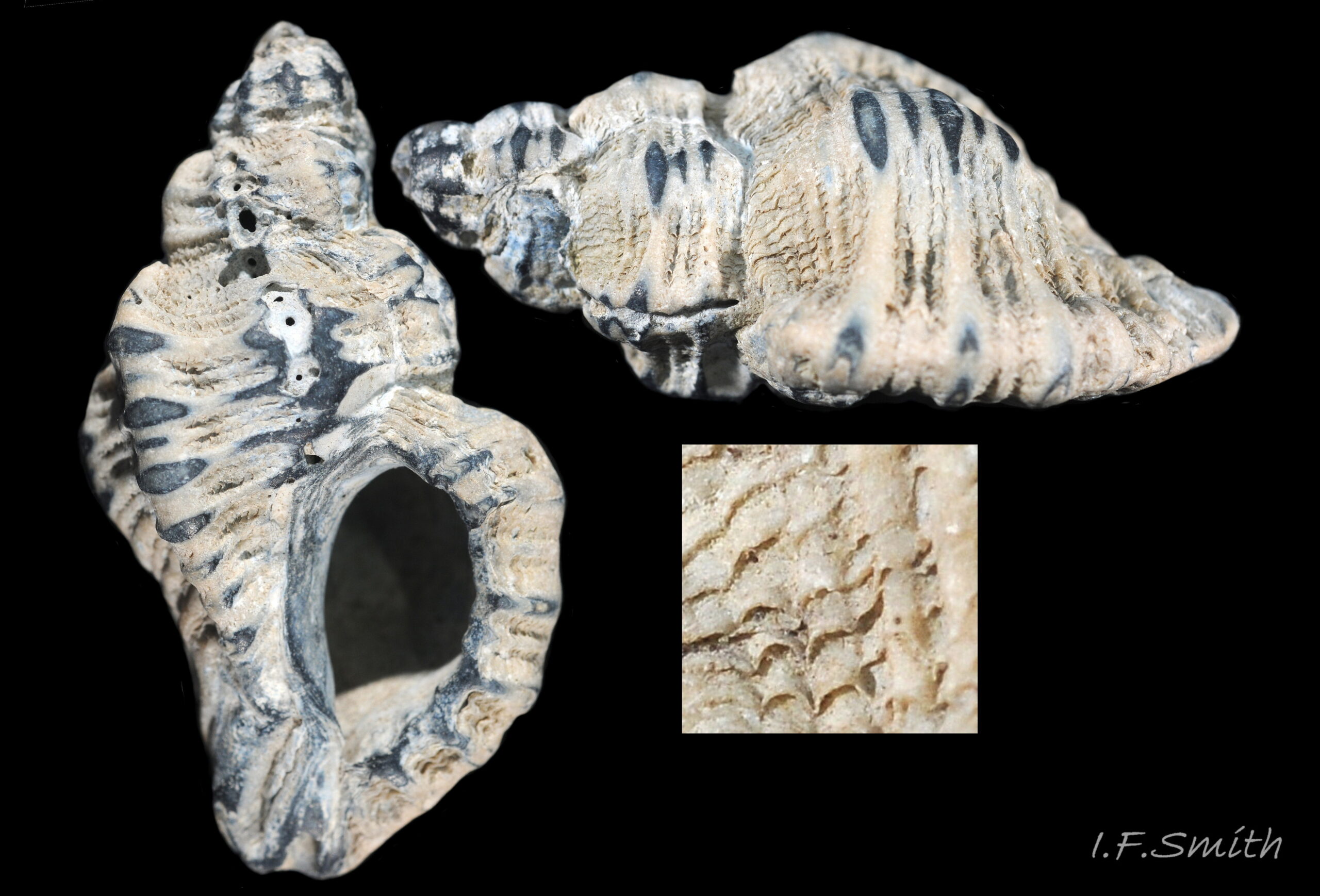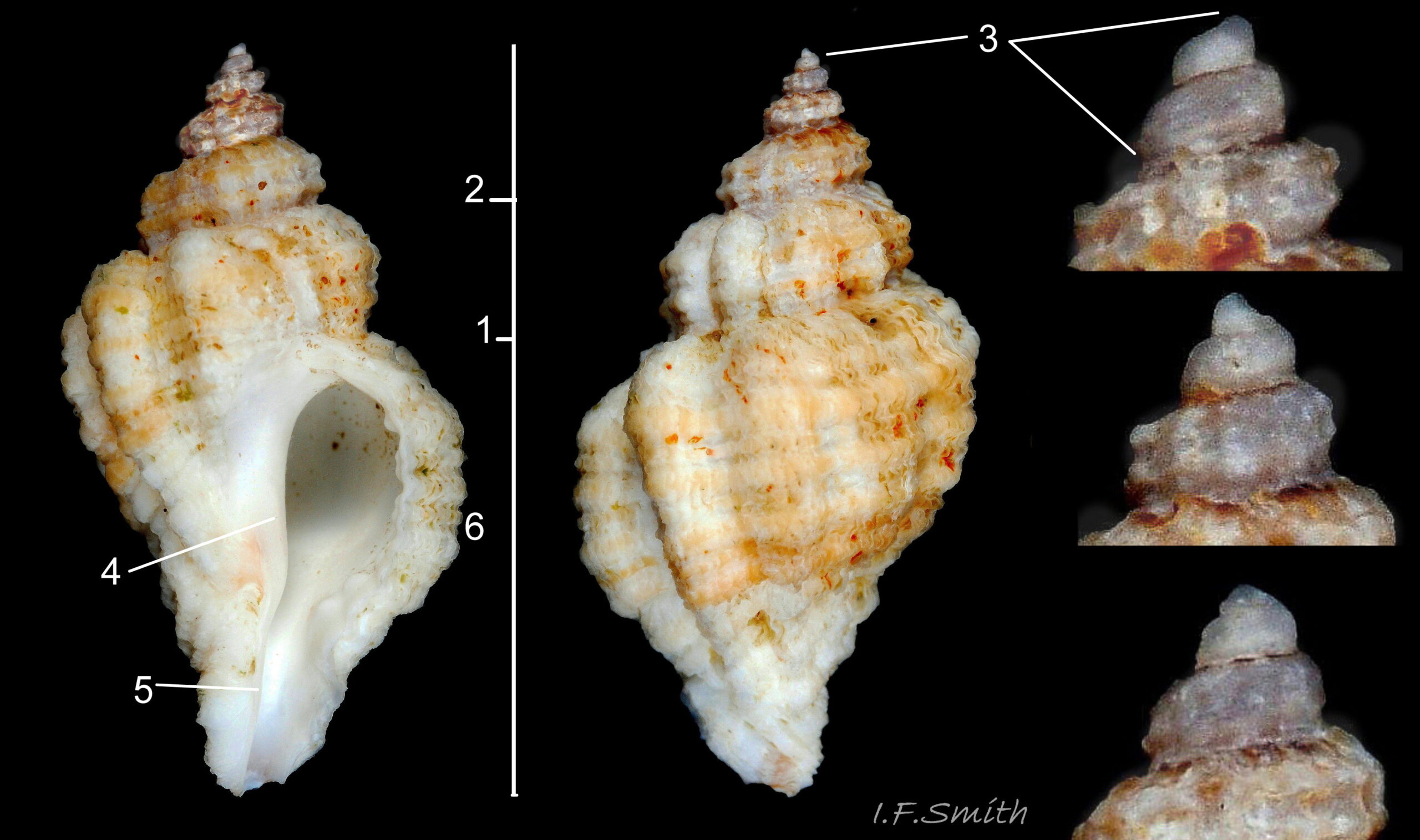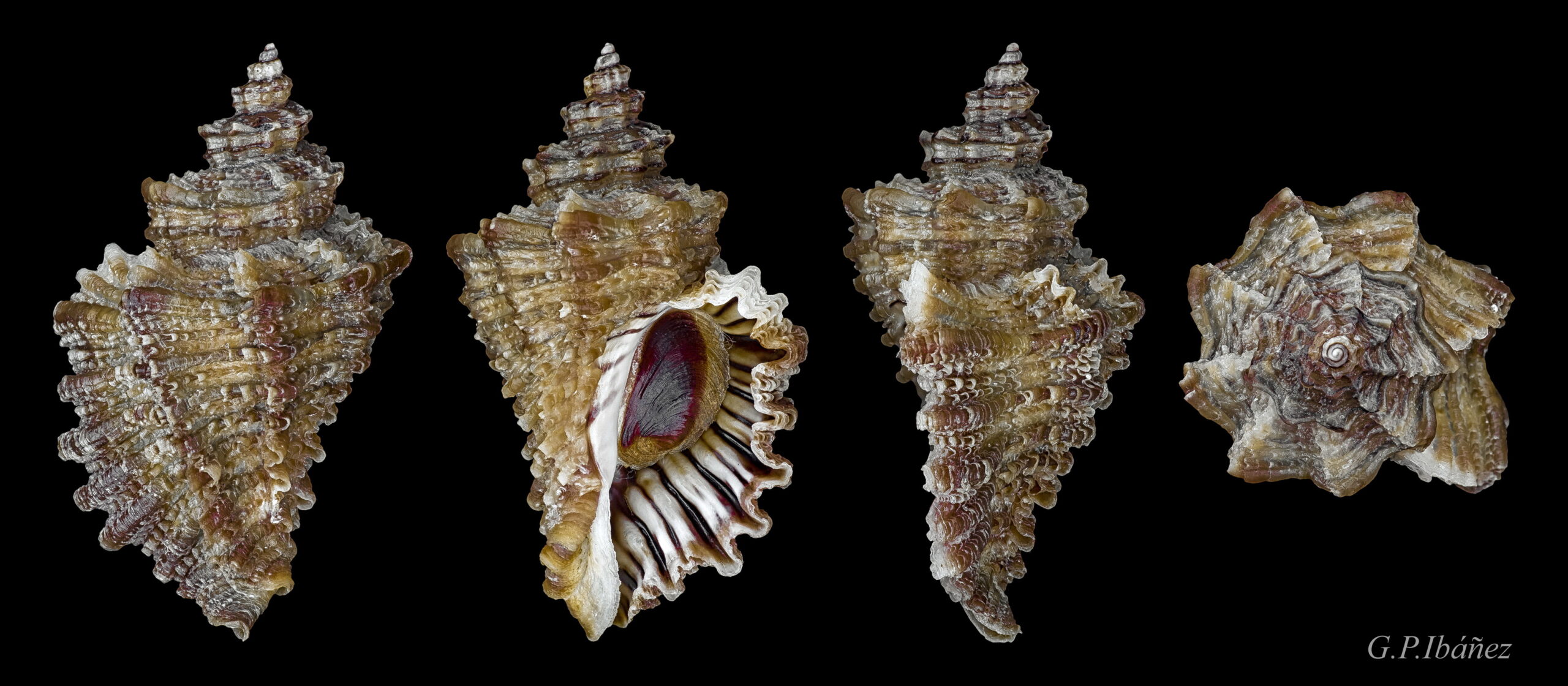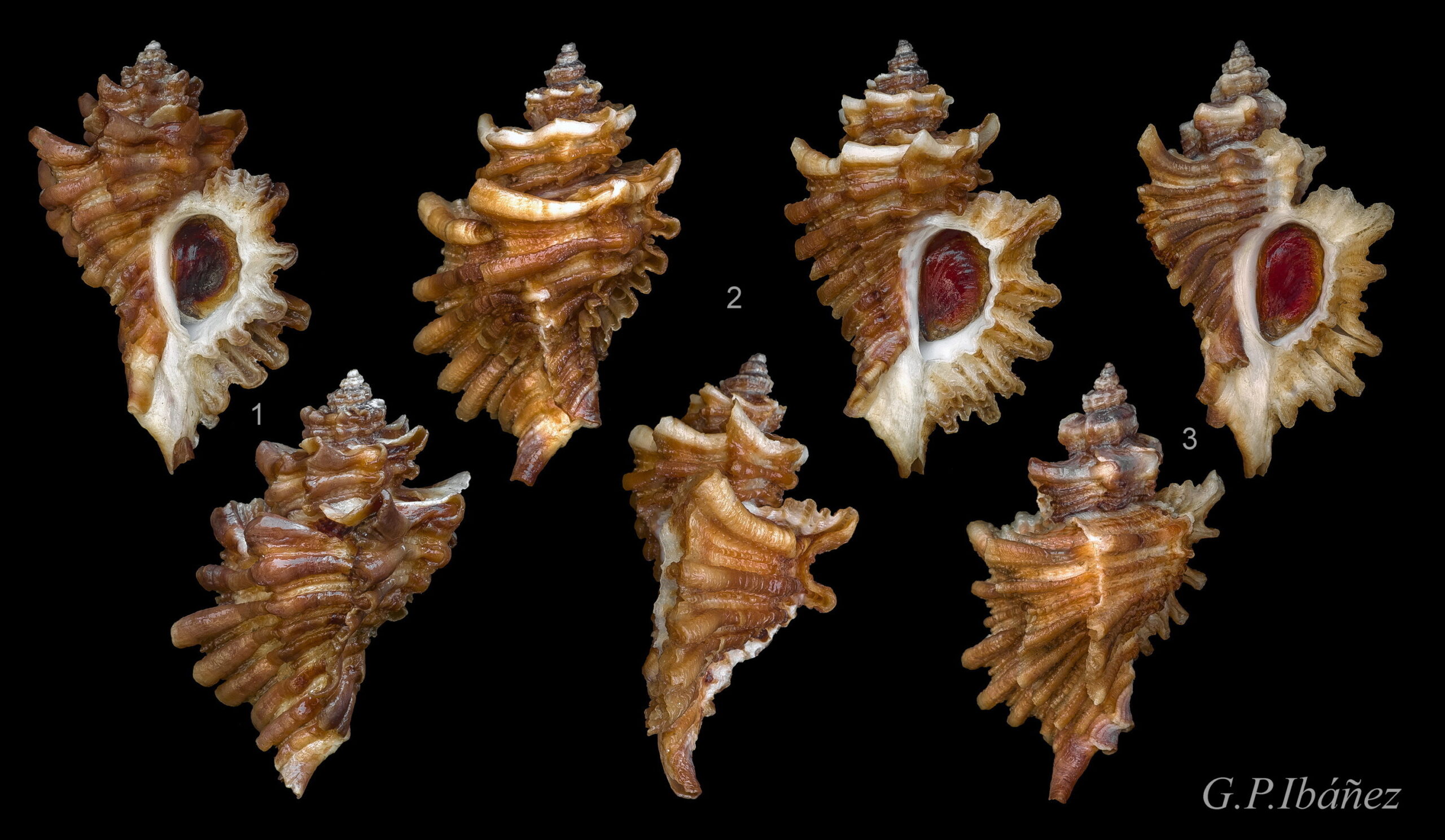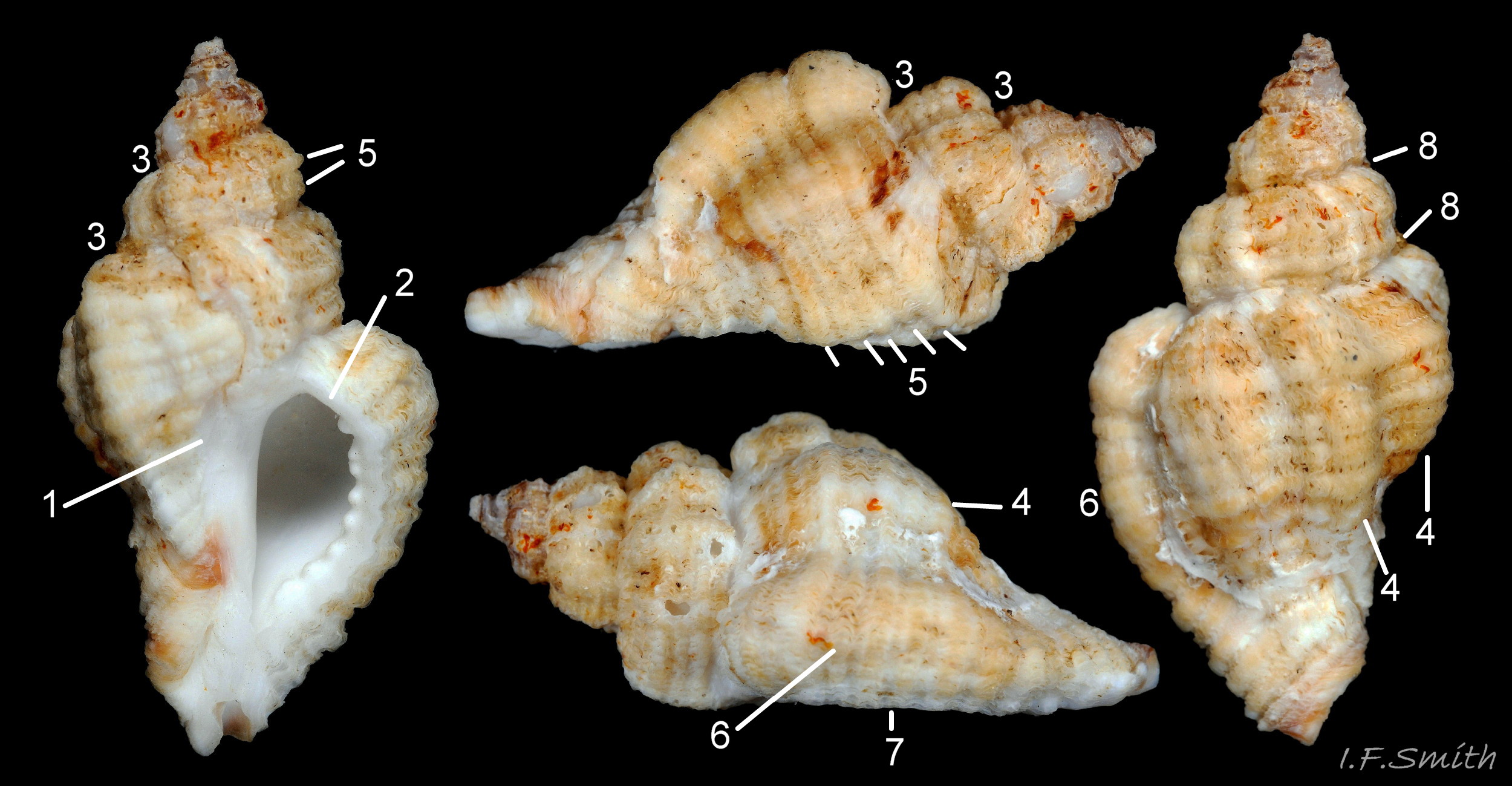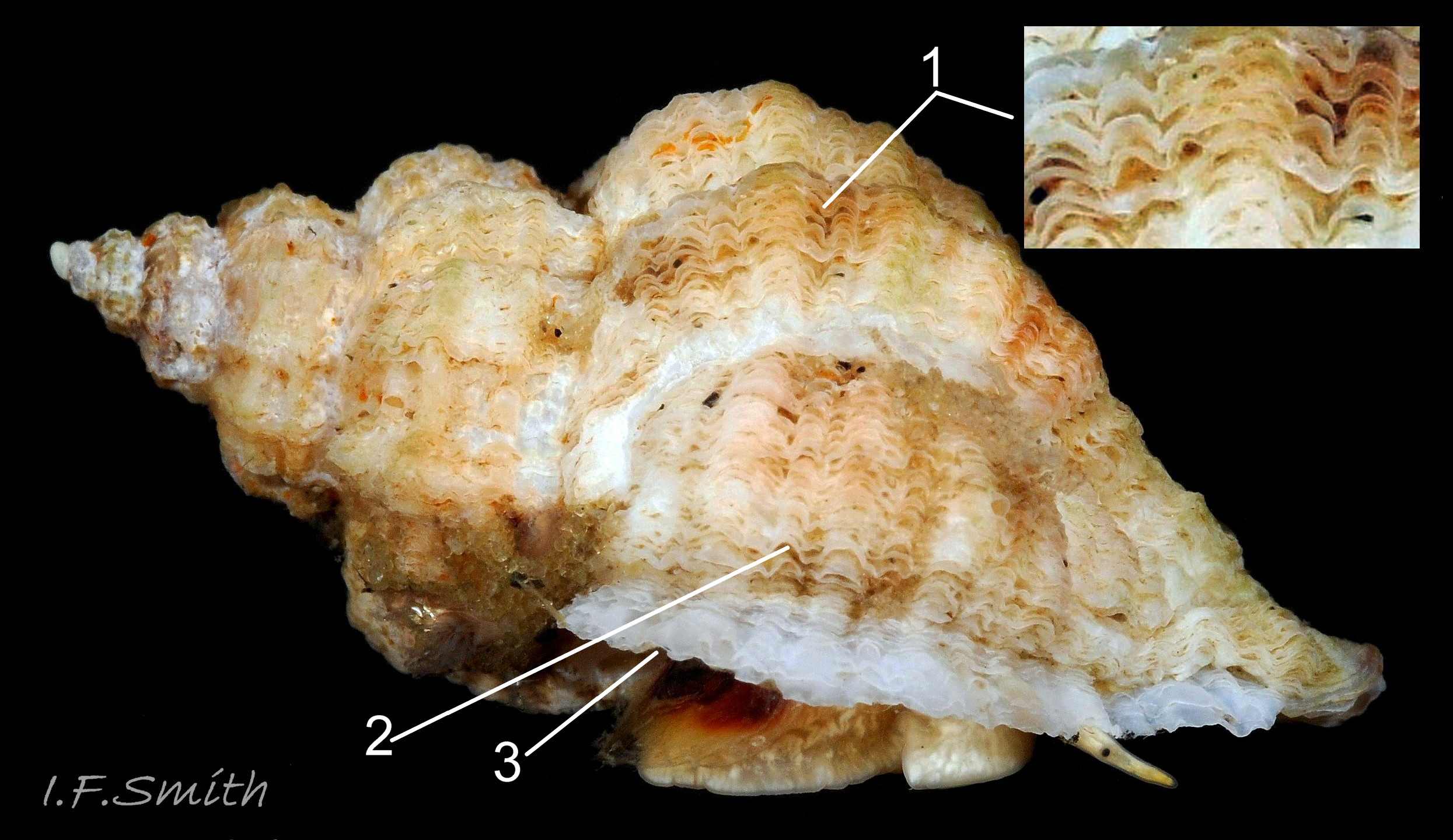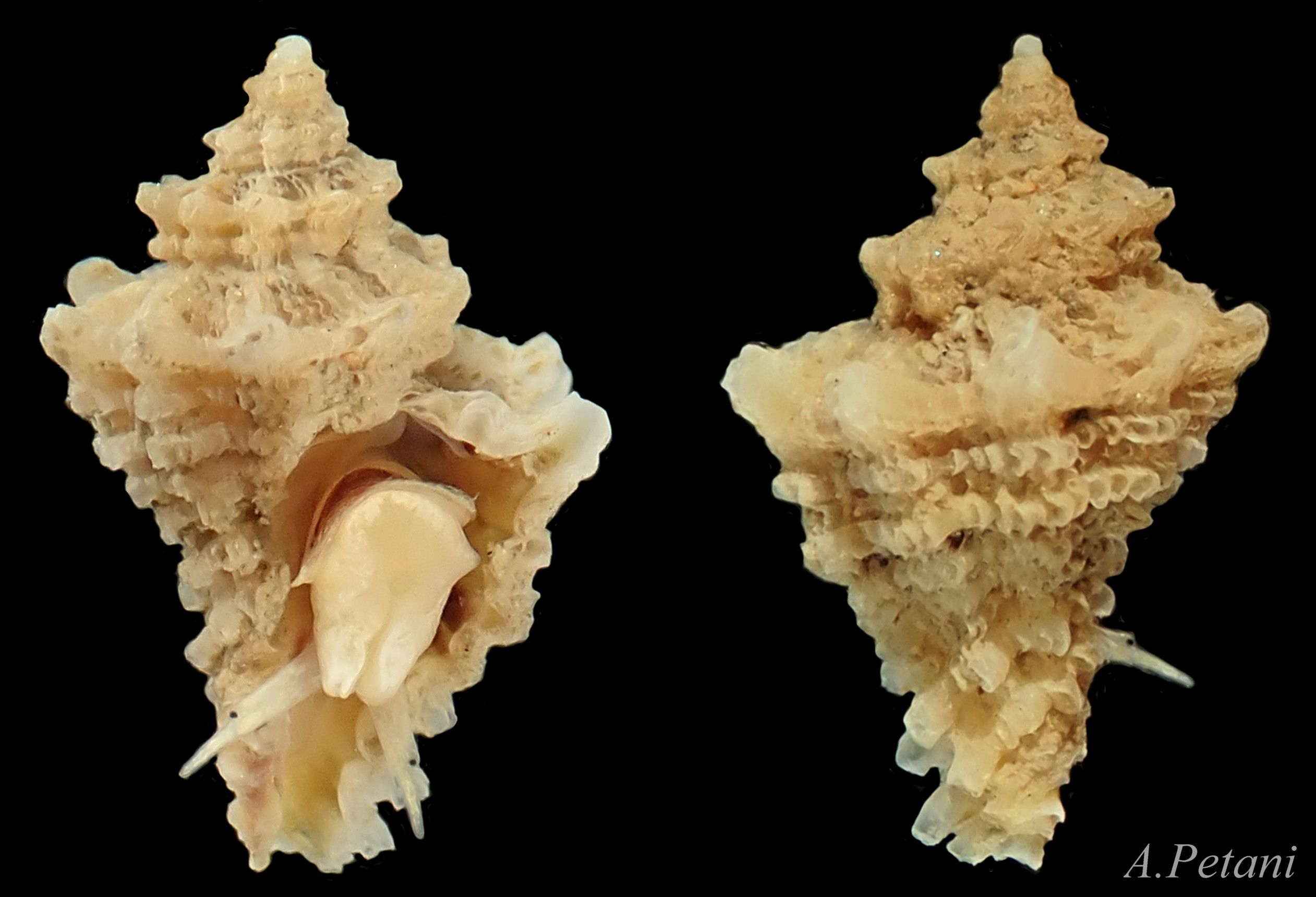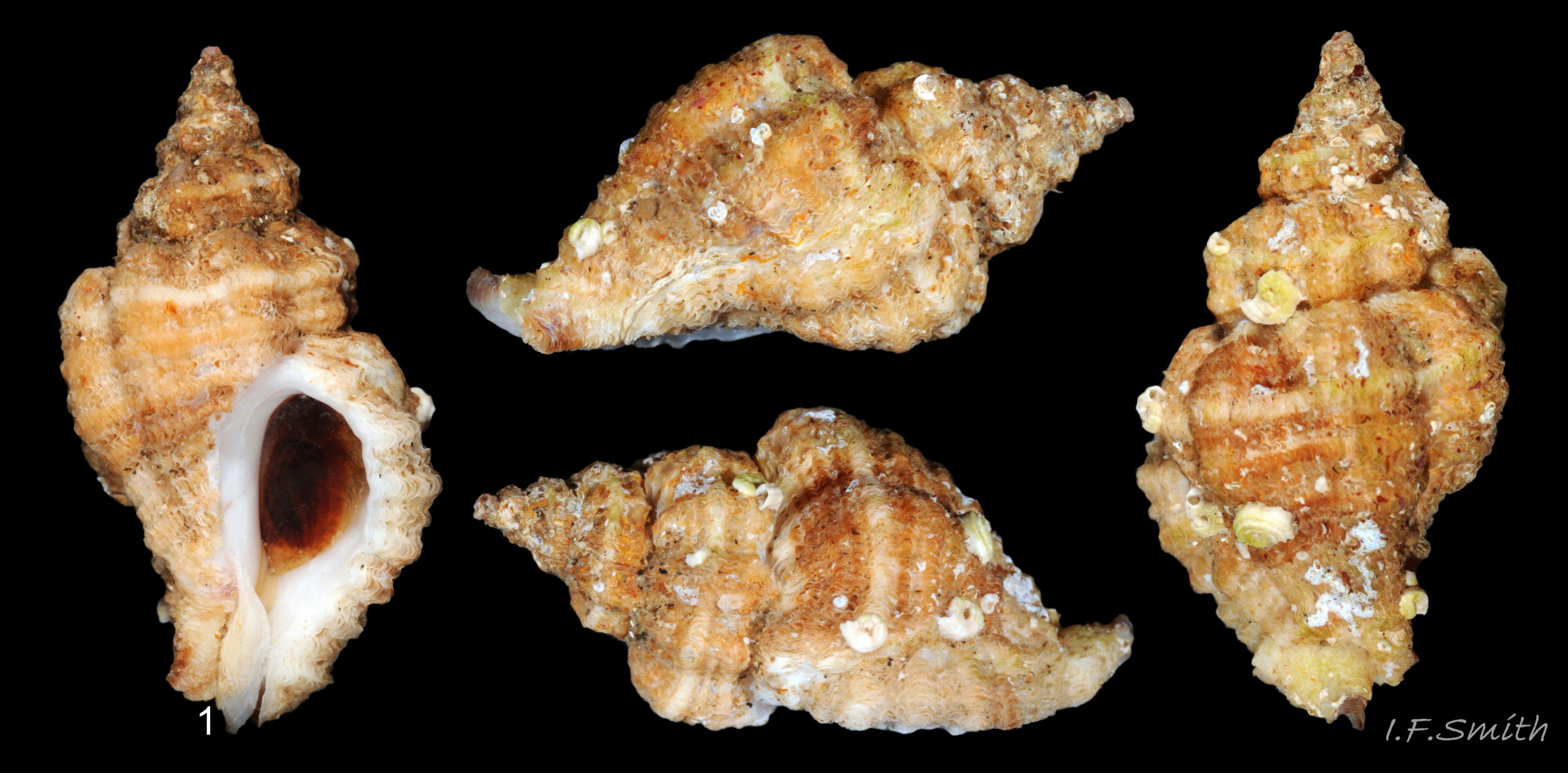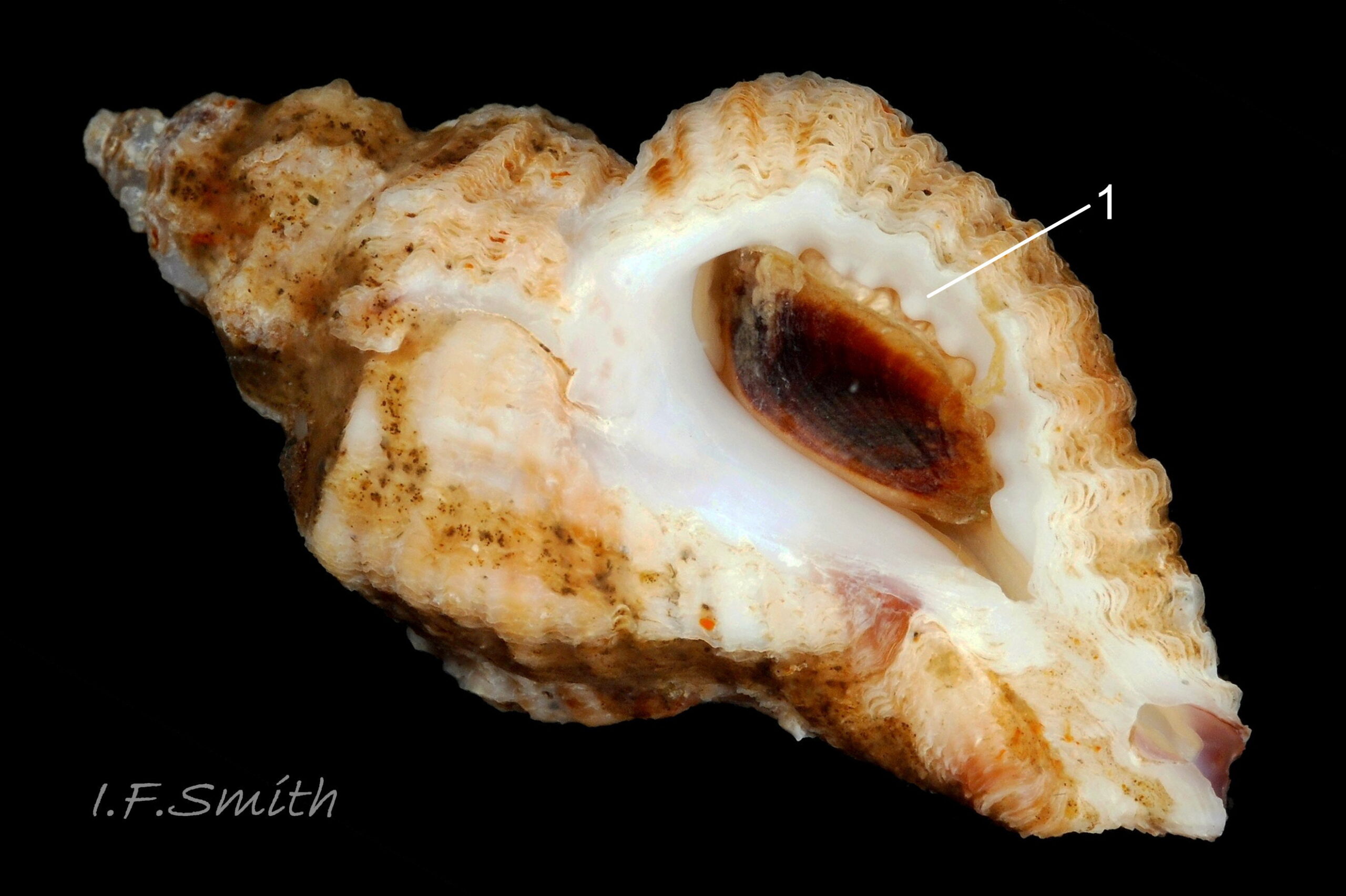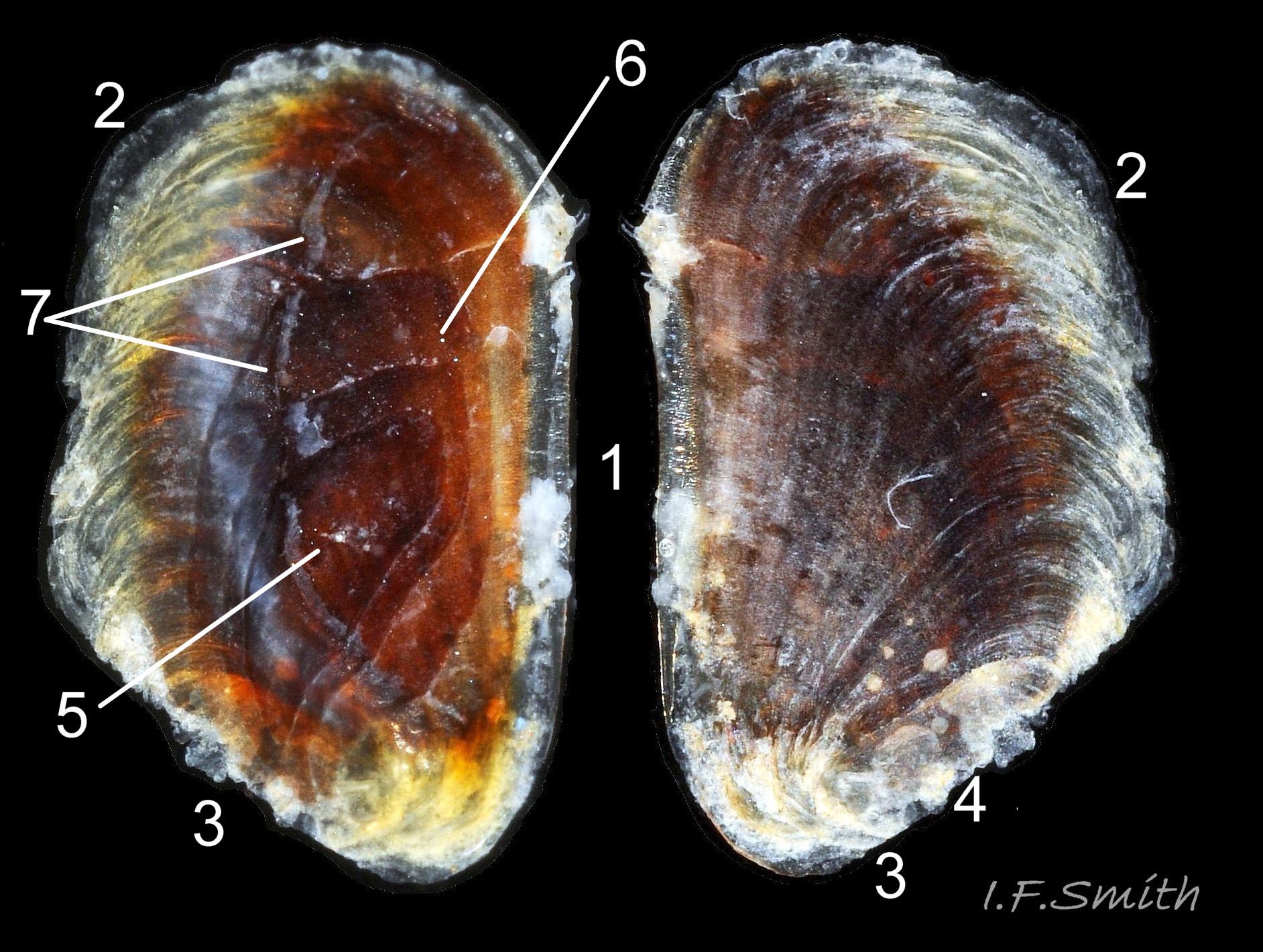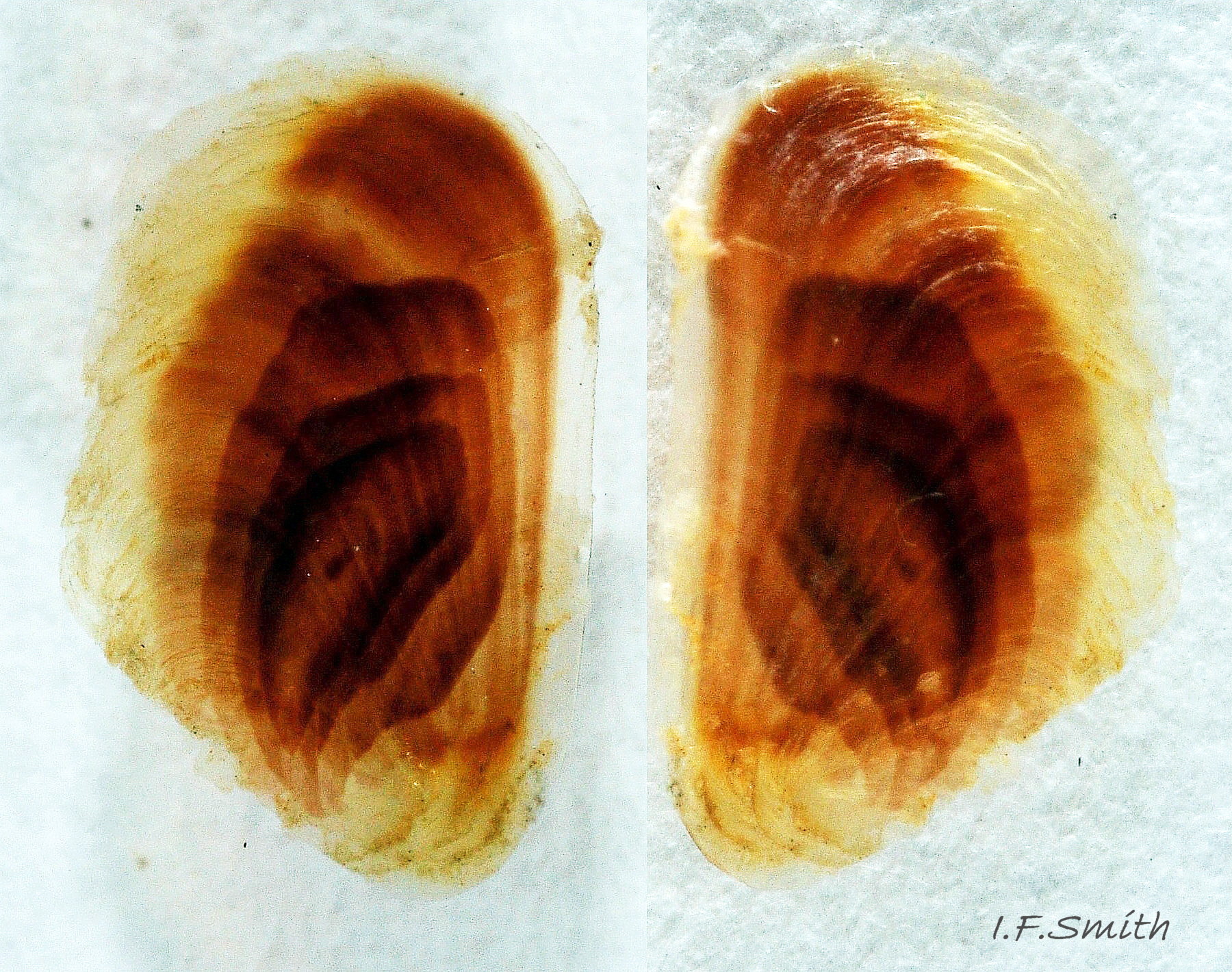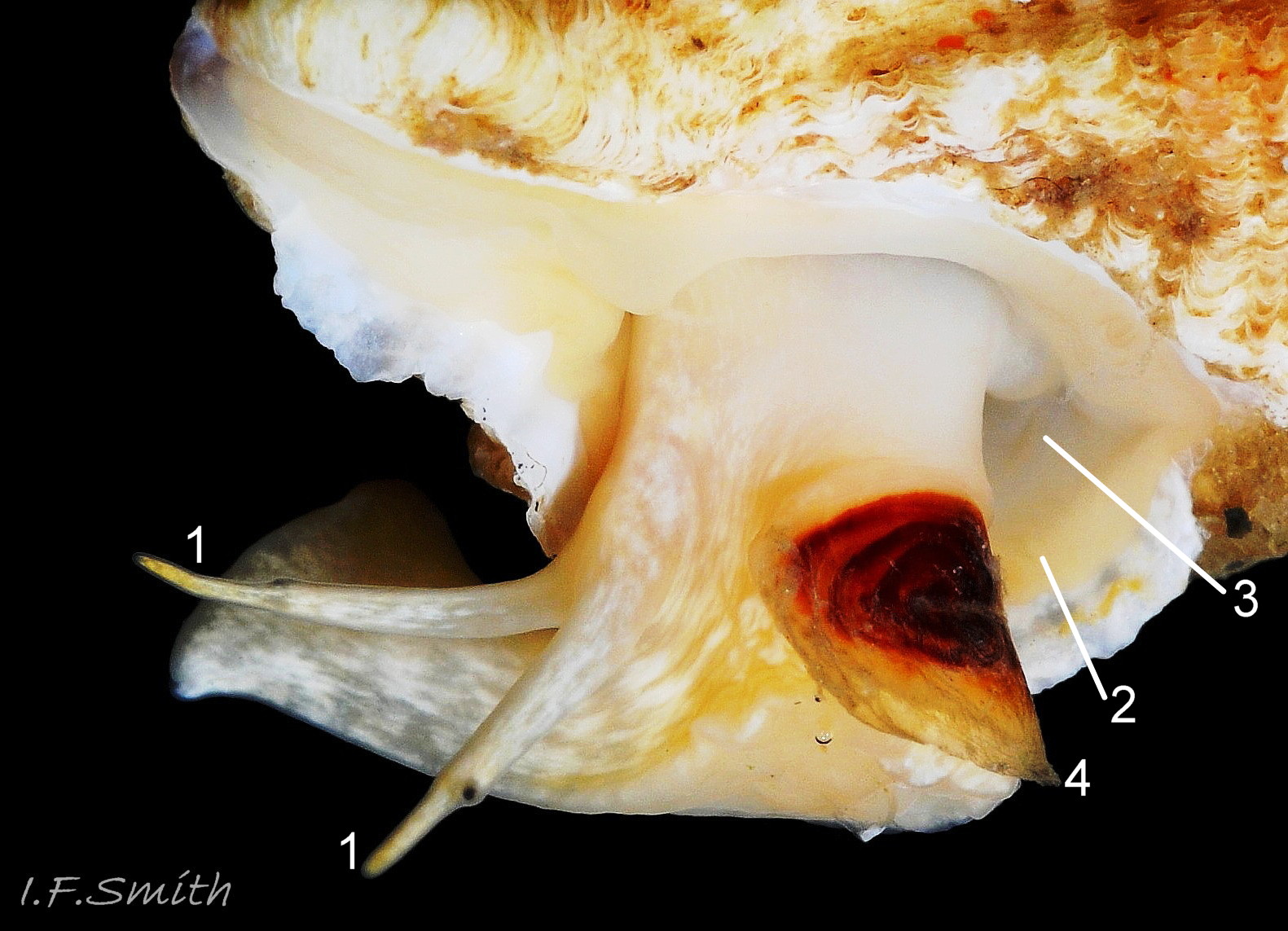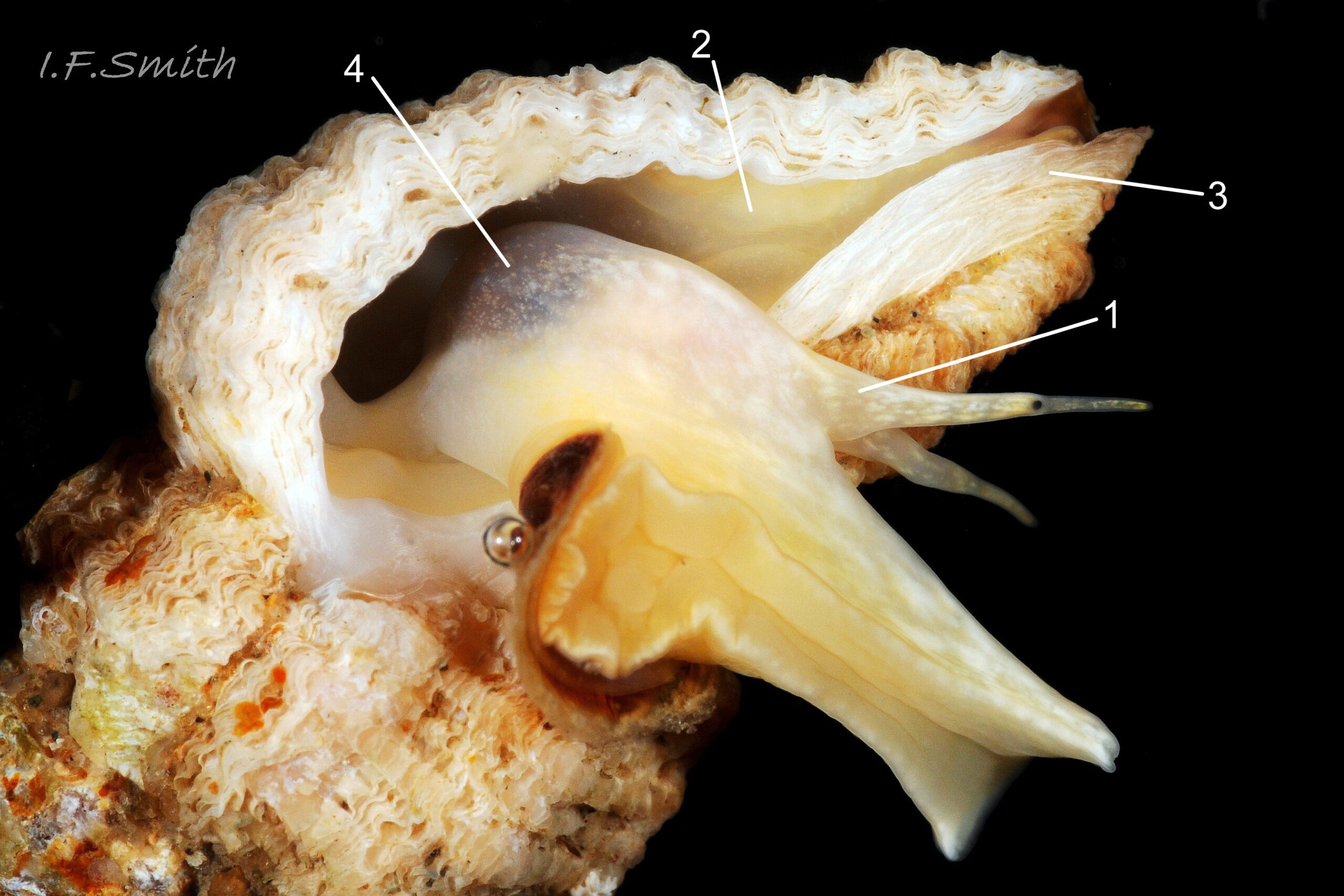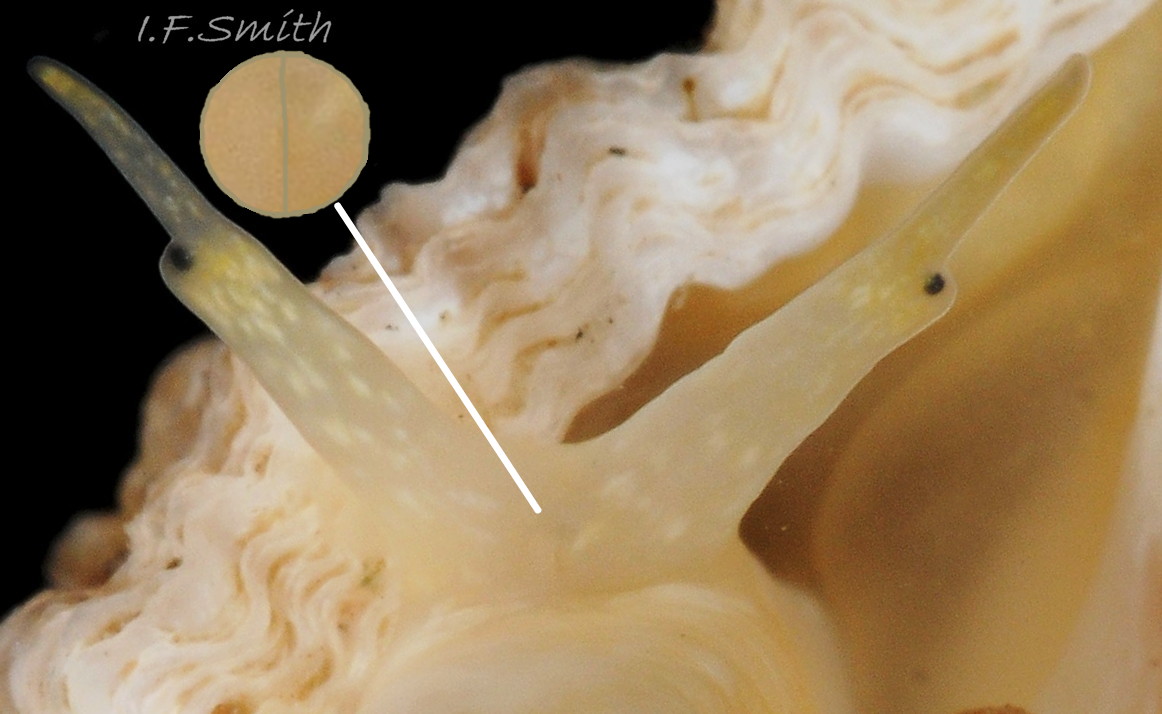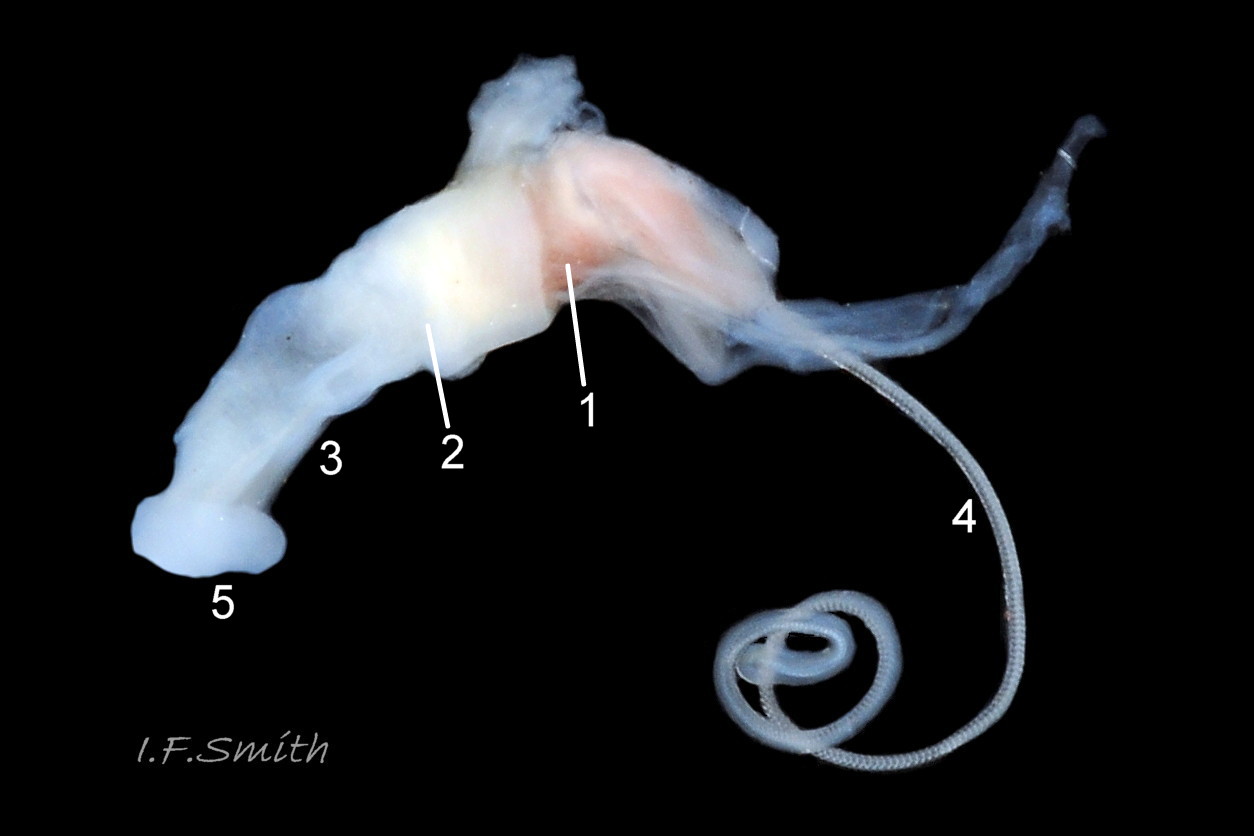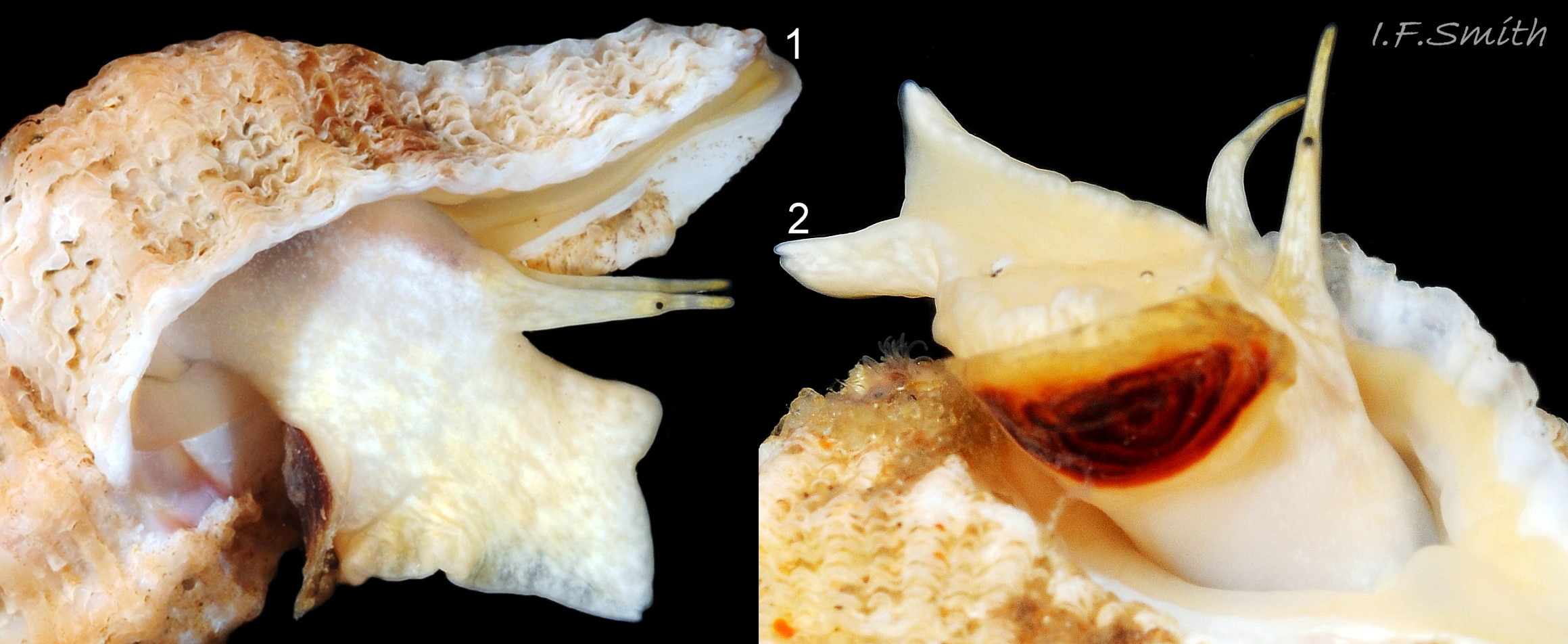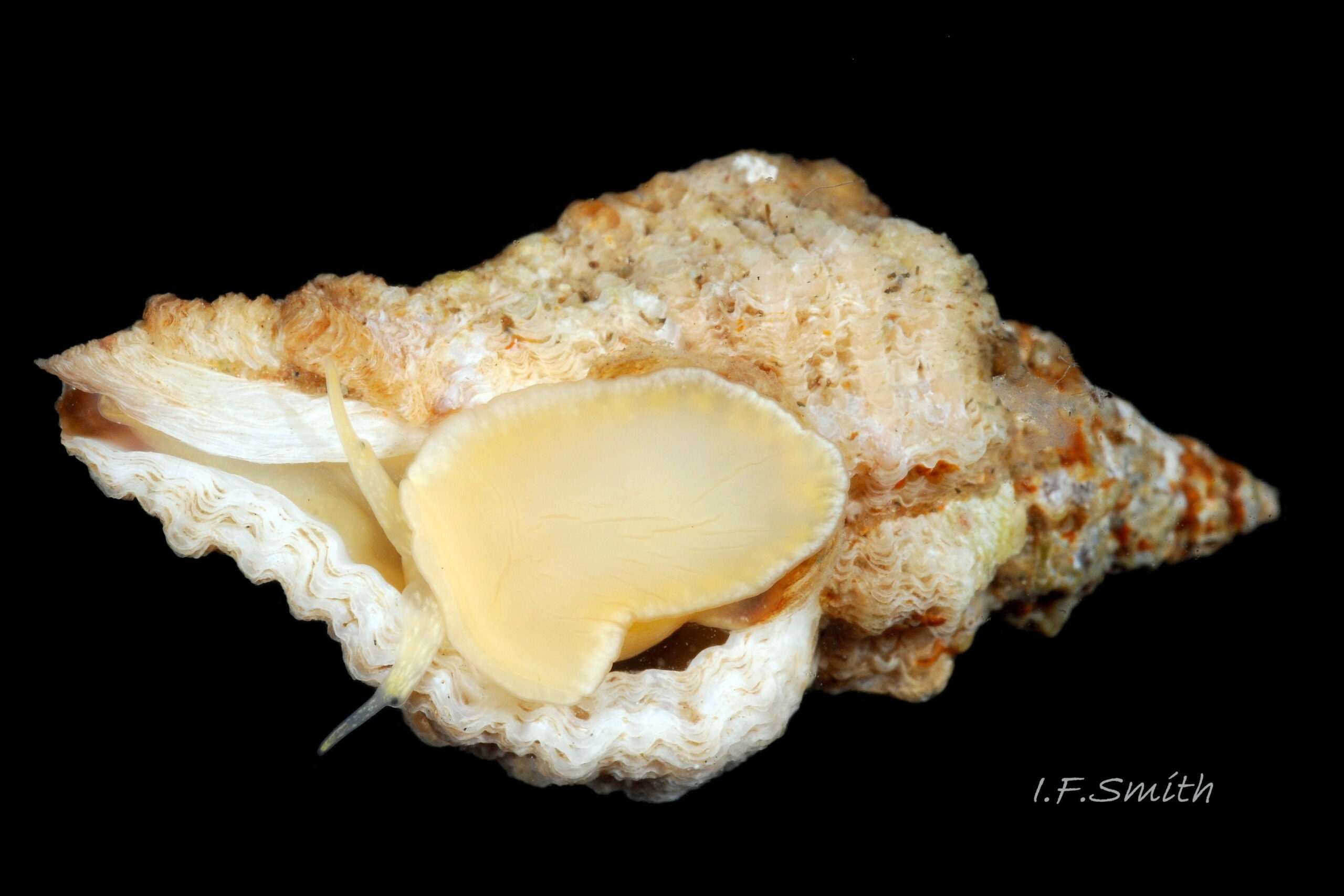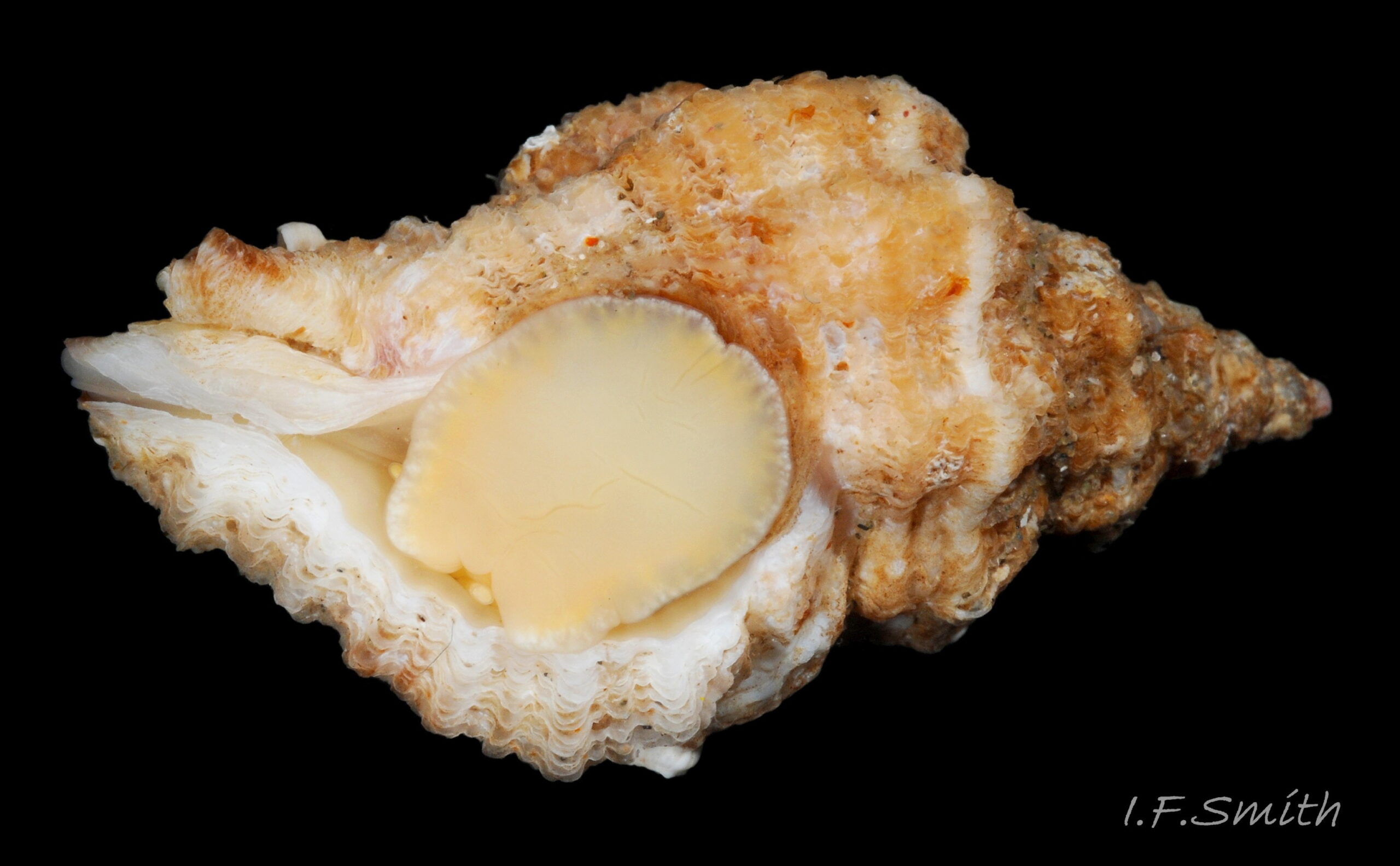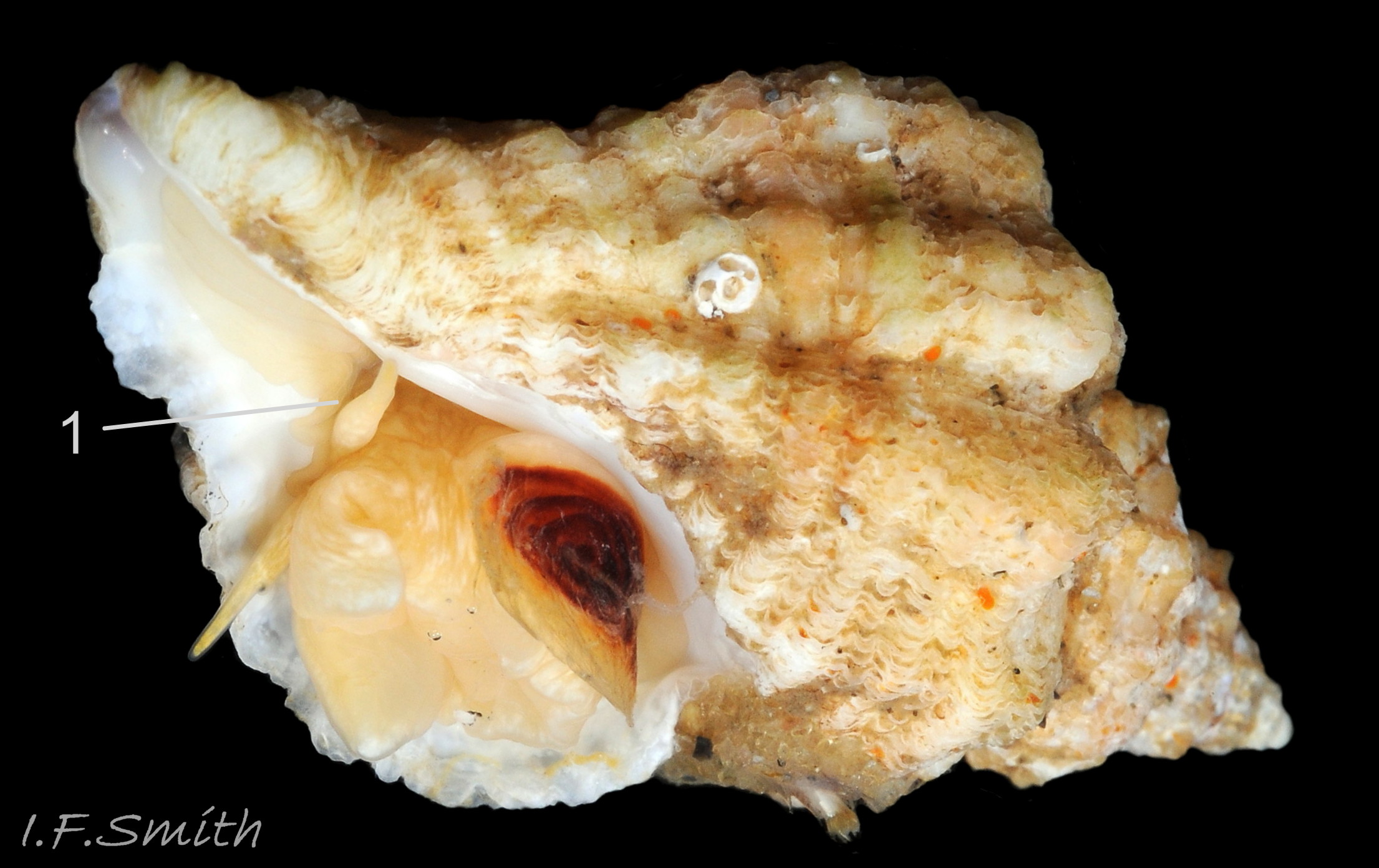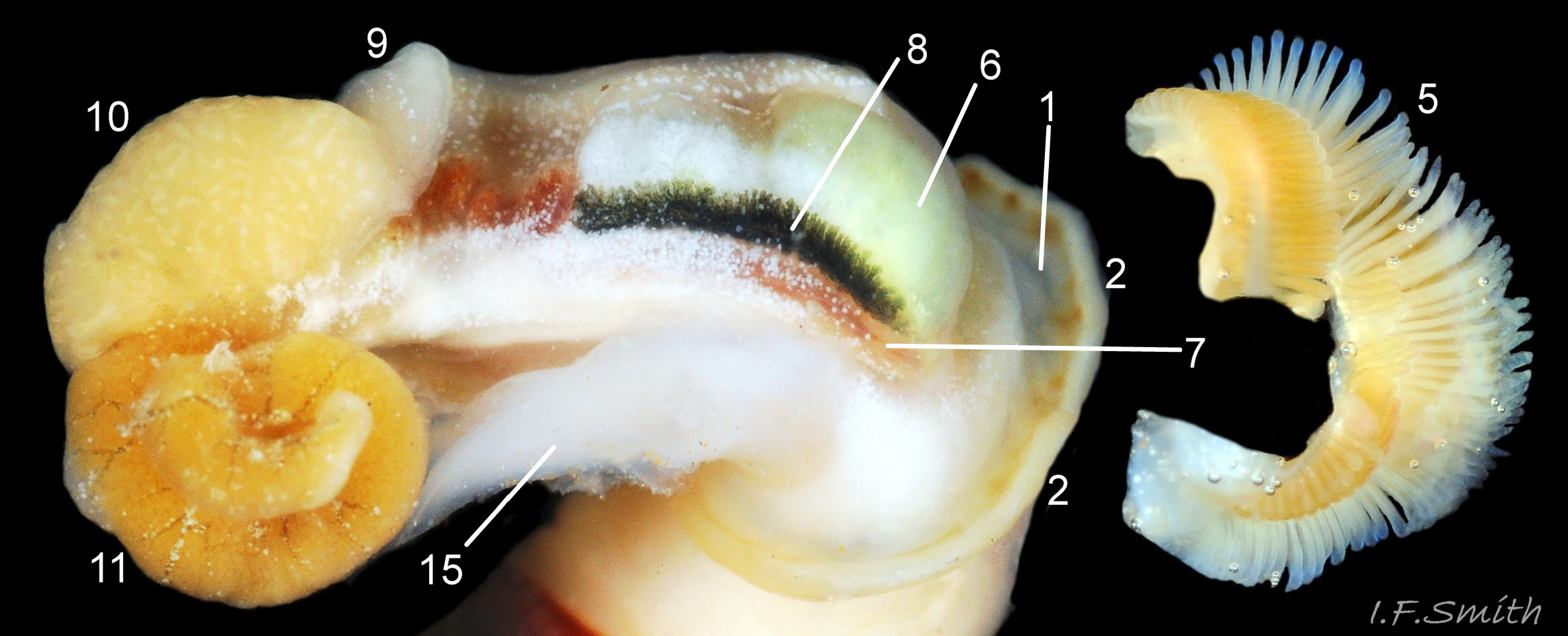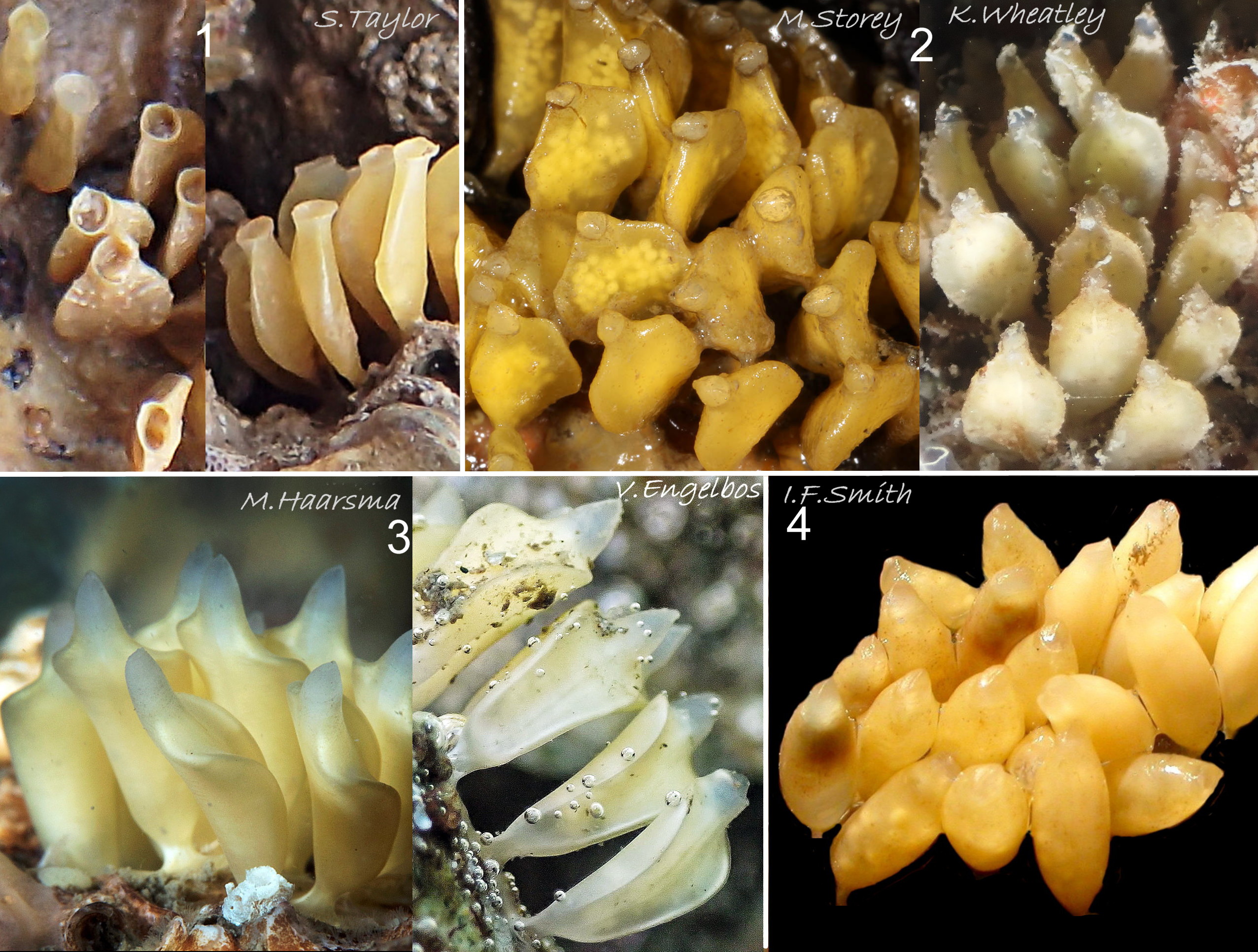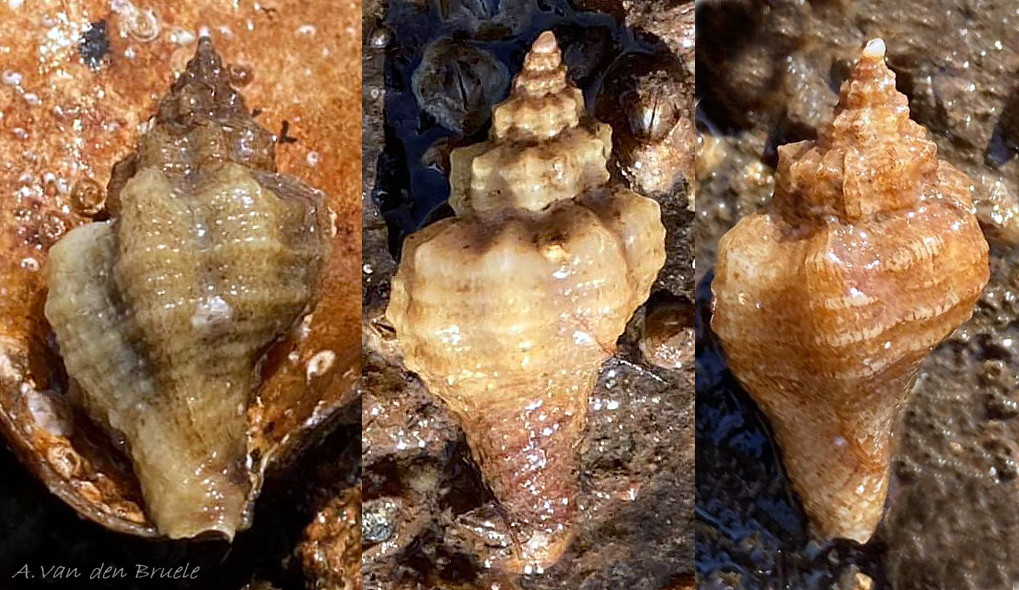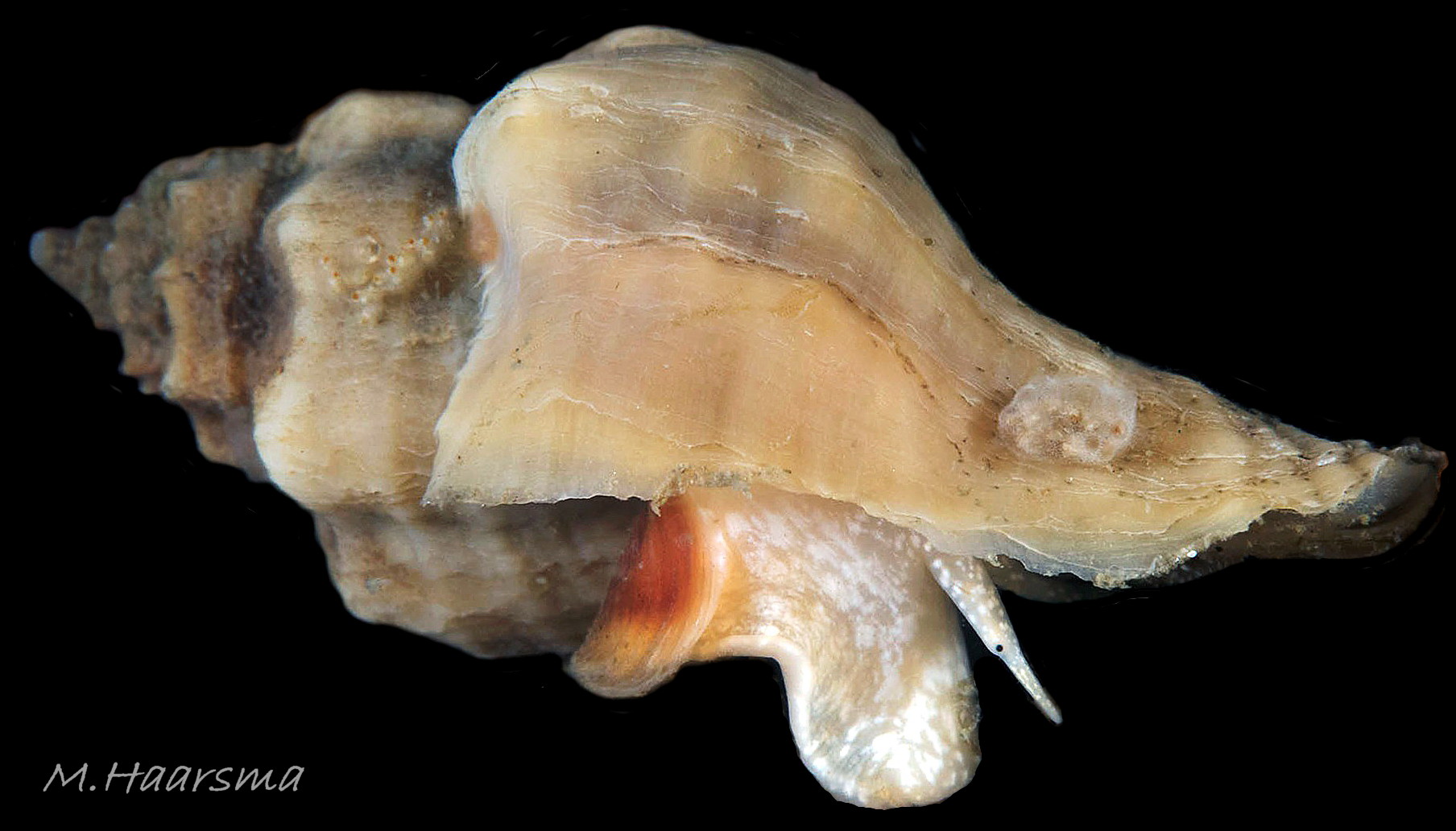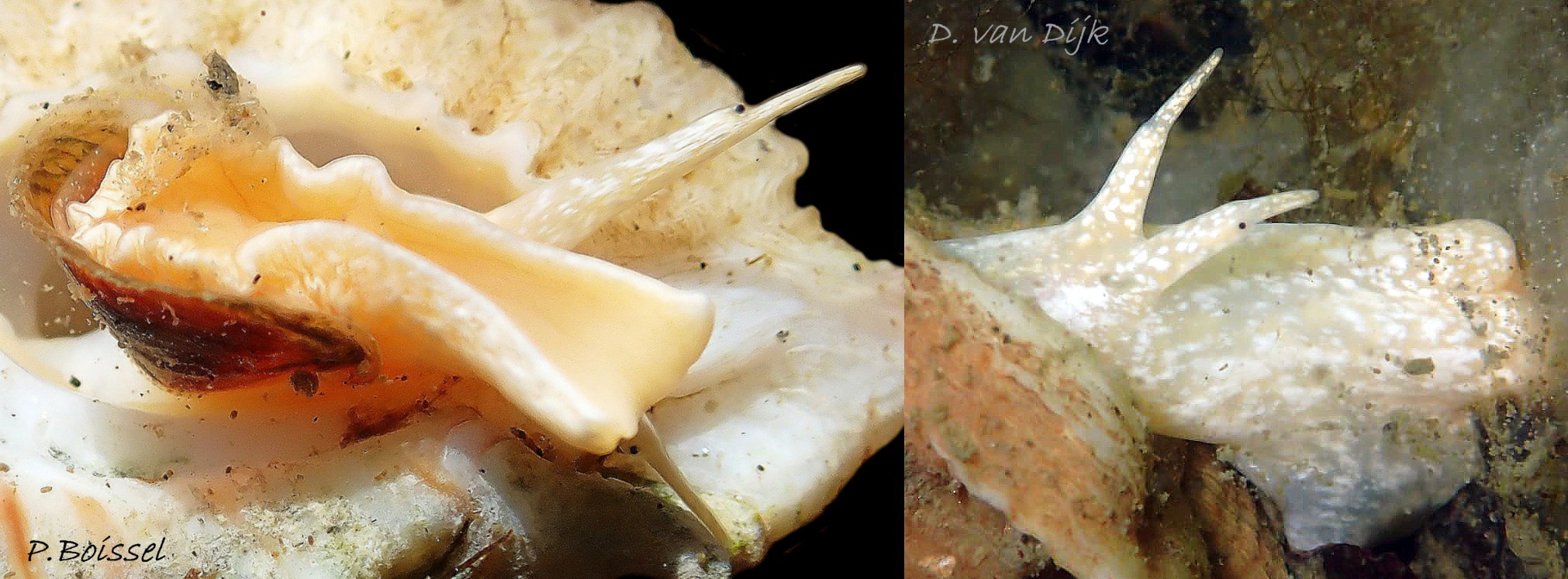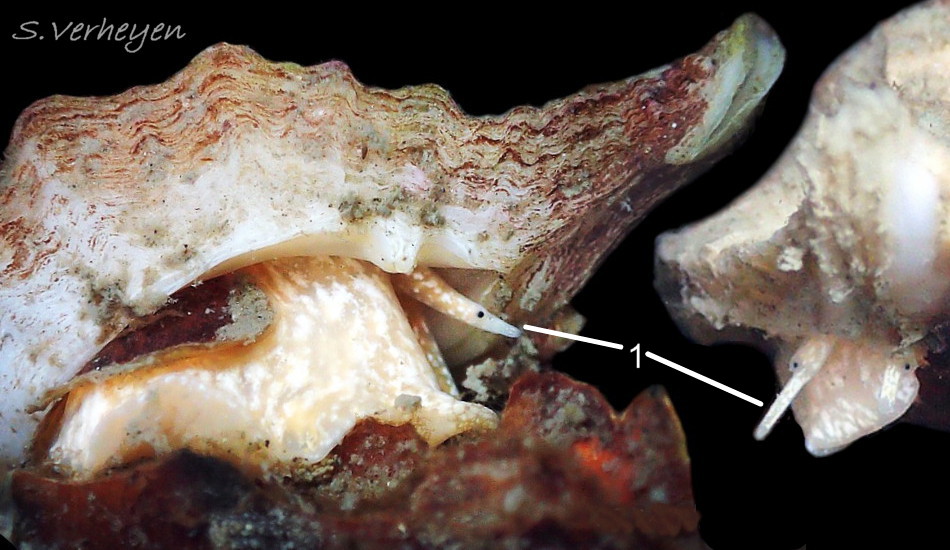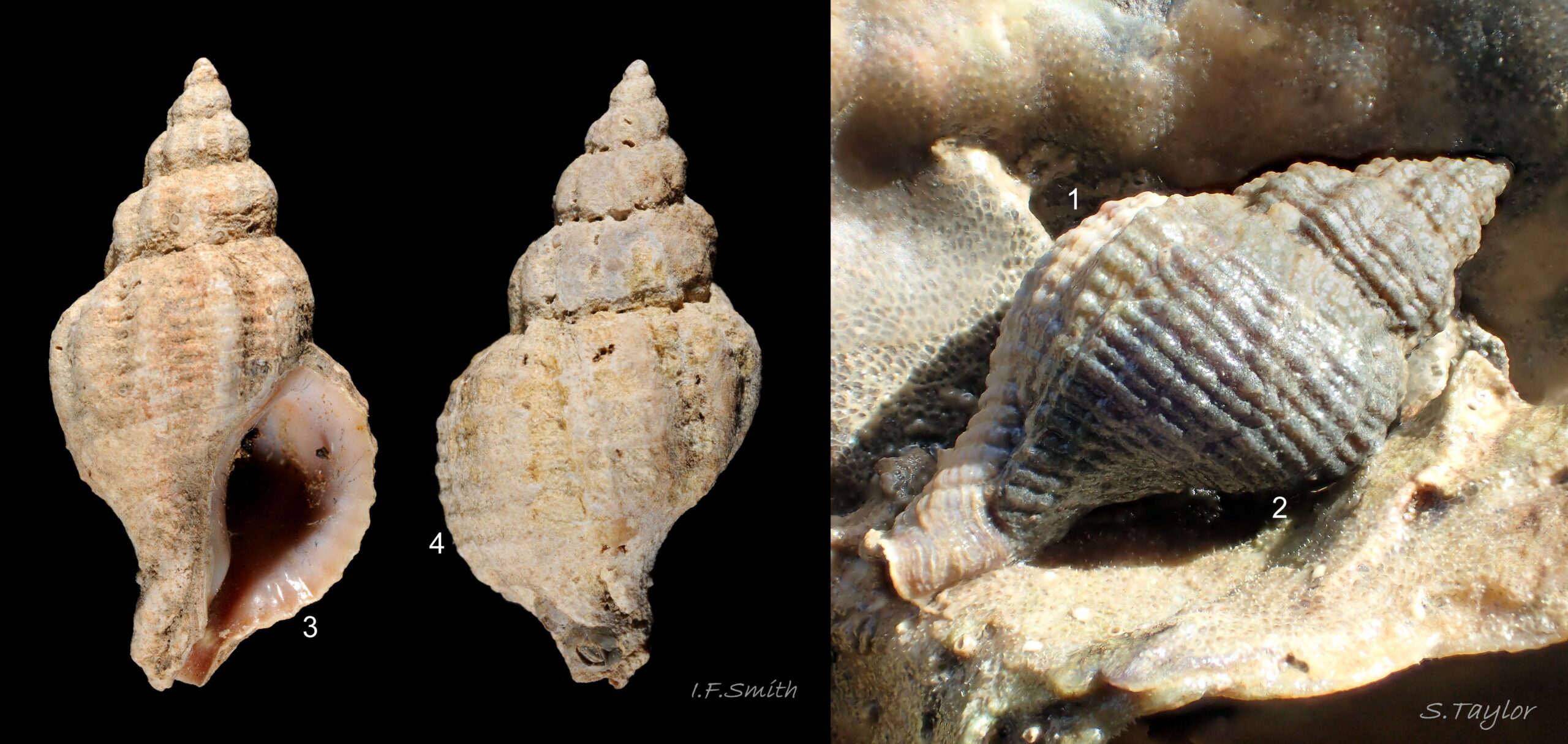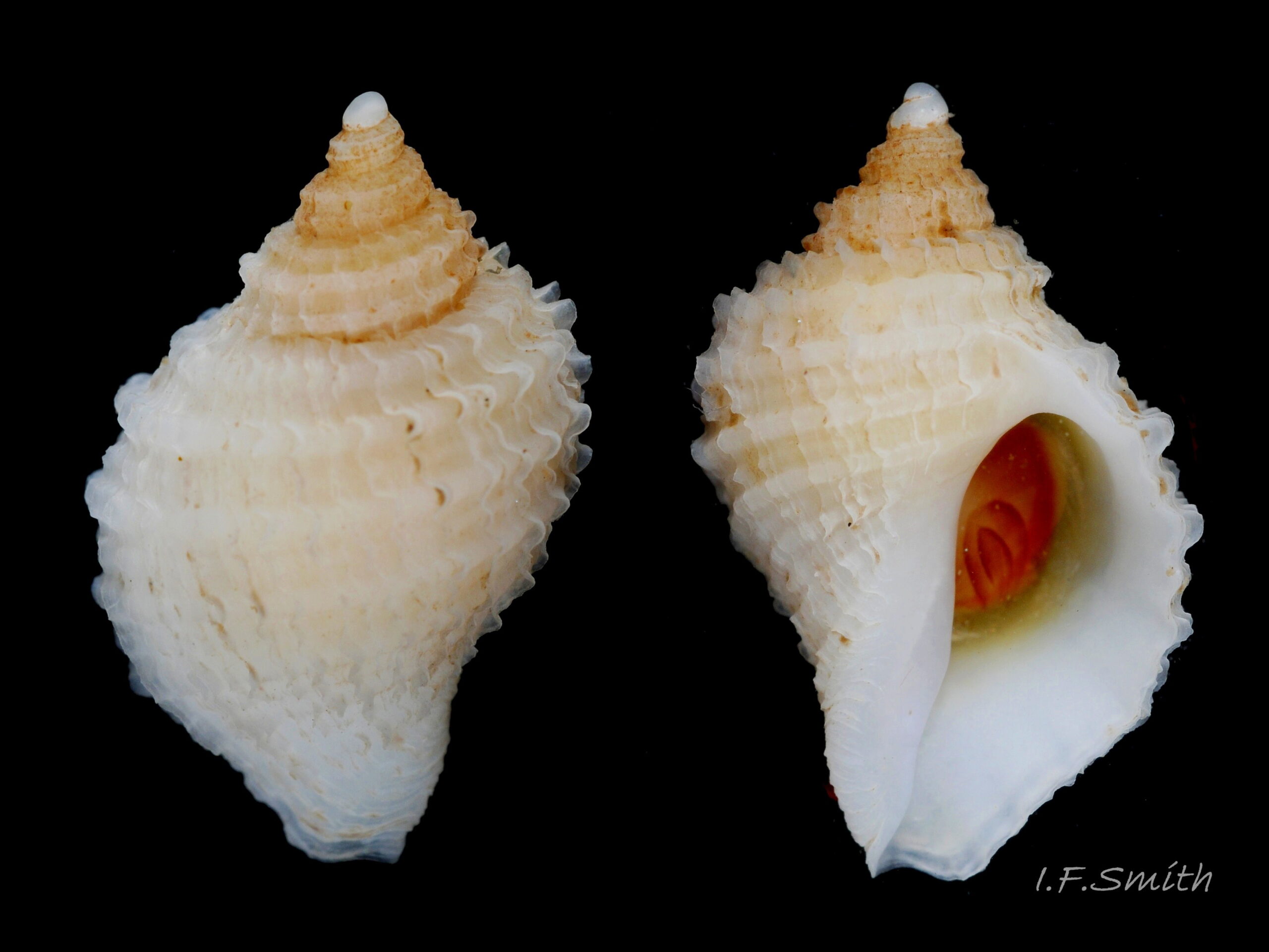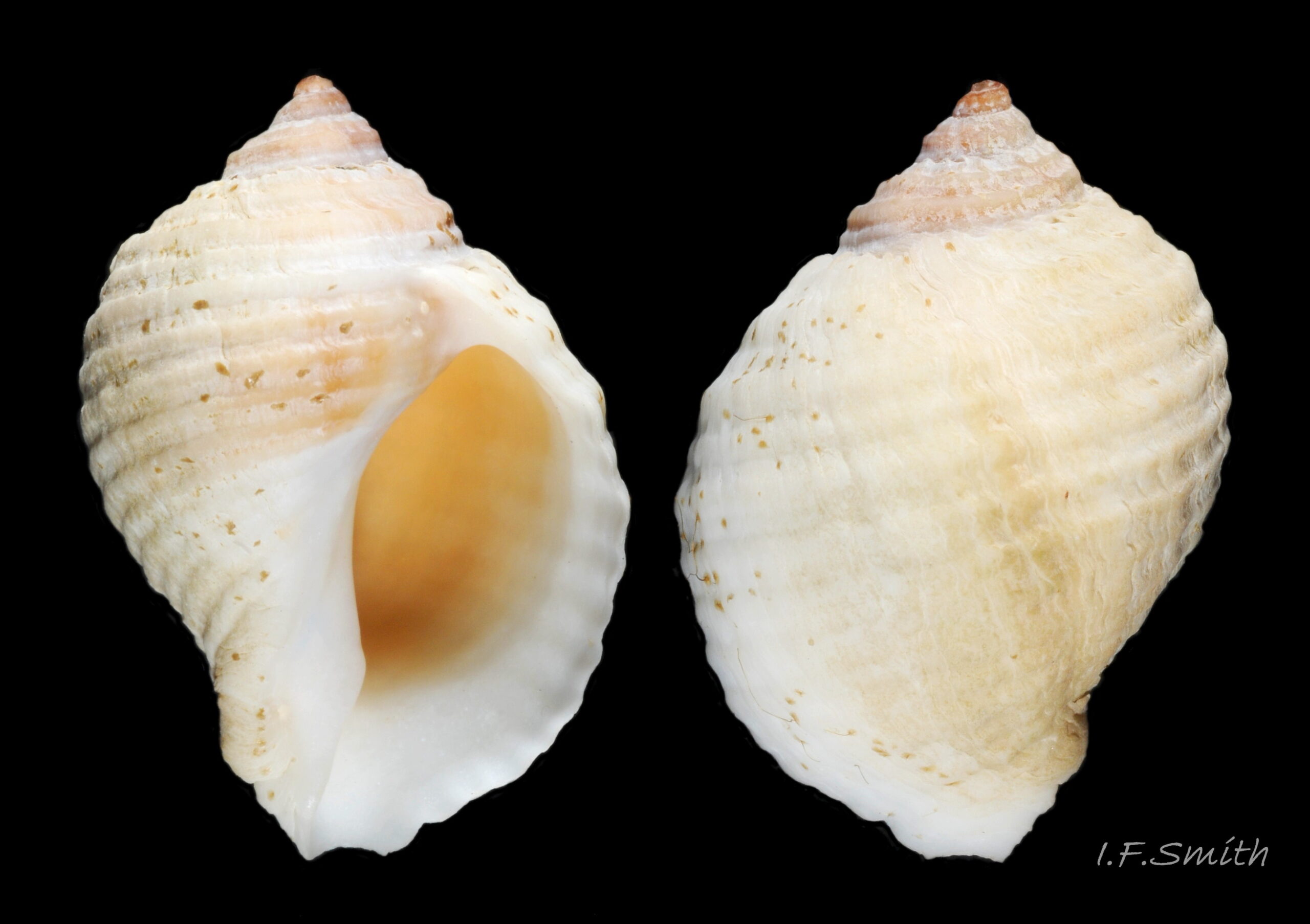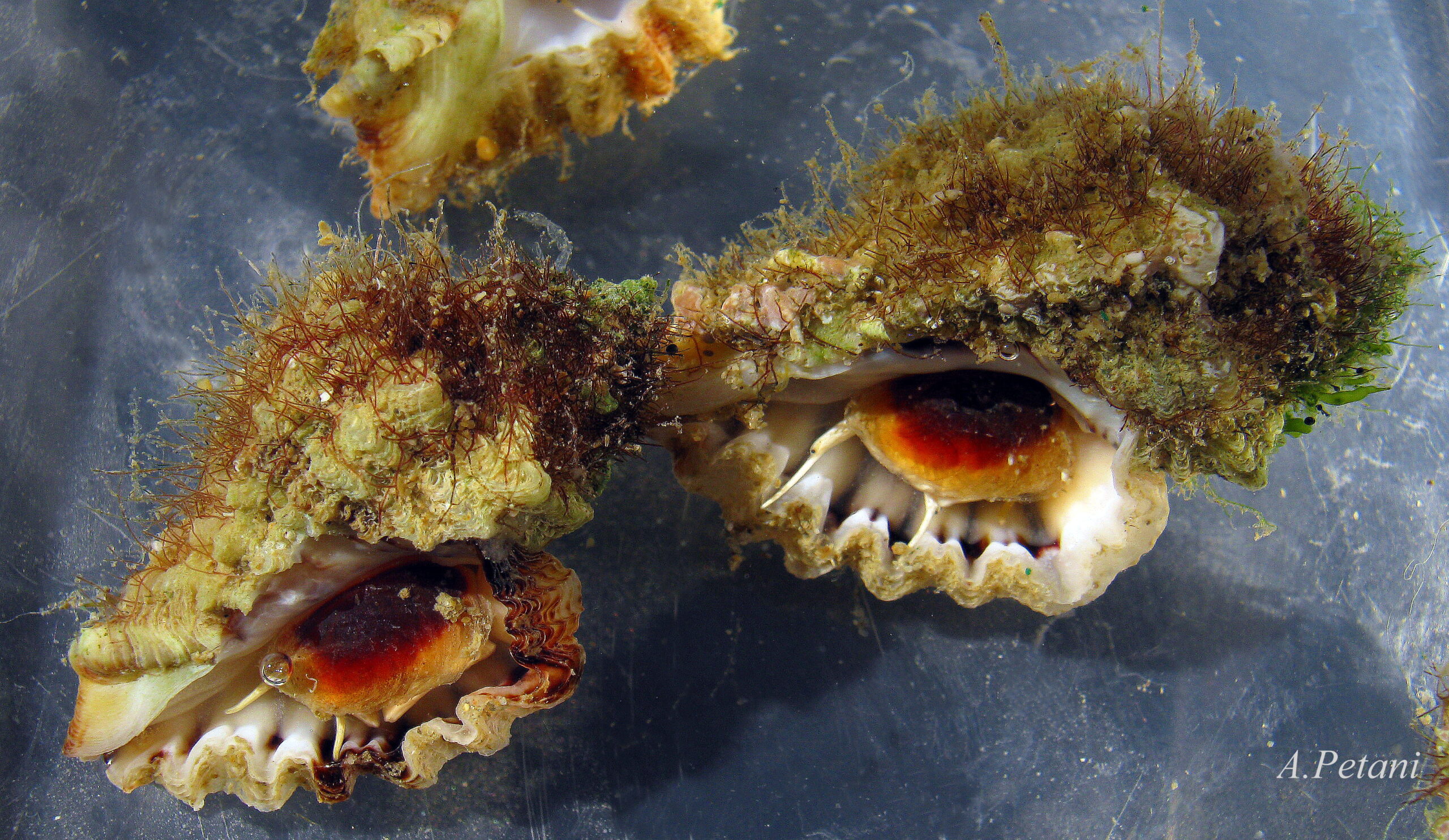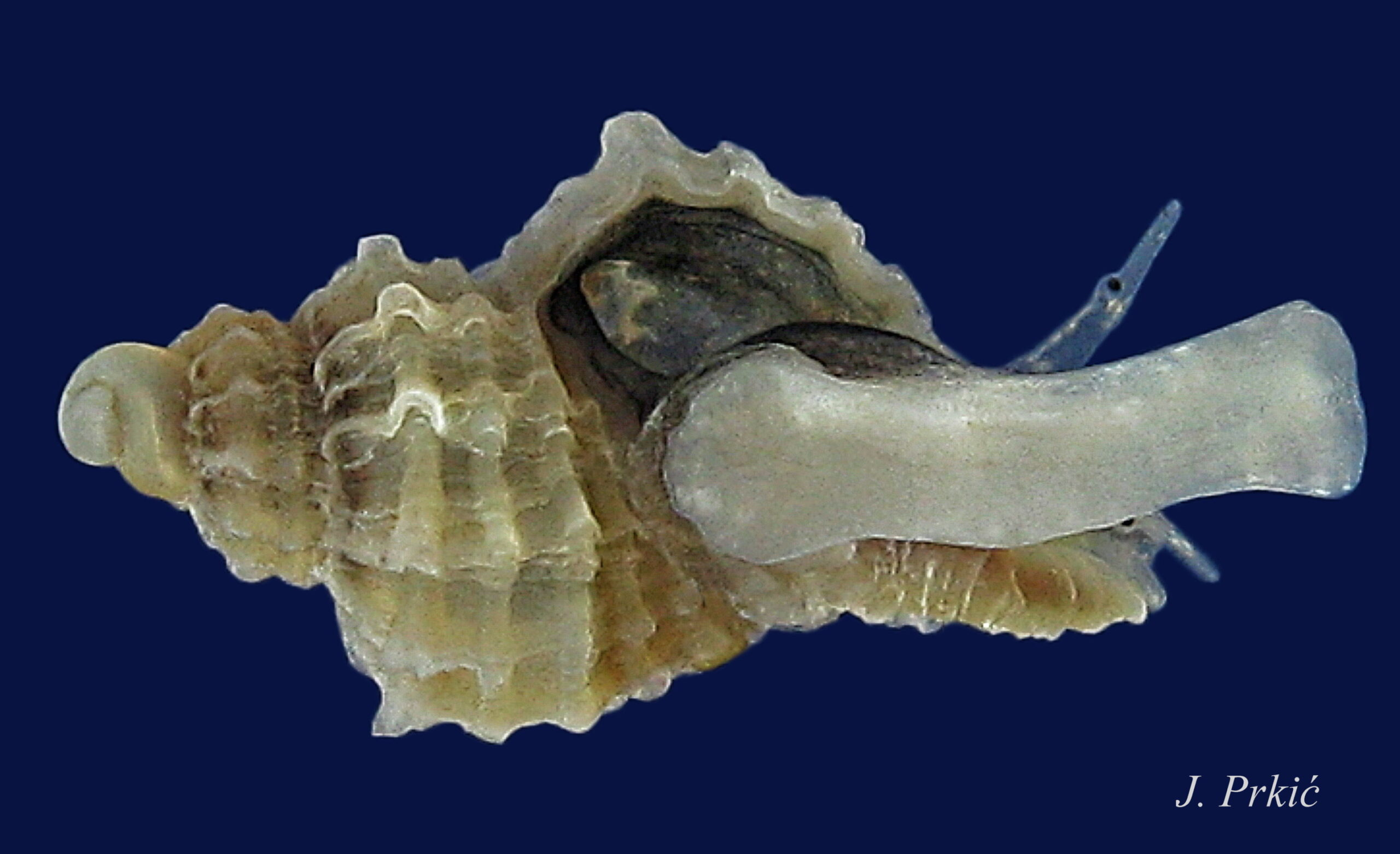Click image to enlarge with full caption. Main text below slider.
Ocenebra erinaceus (Linnaeus, 1758).
PDF avaialable at www.researchgate.net/publication/369537725_Ocenebra_erina…
Synonyms: Murex erinaceus Linnaeus, 1758; Ocenebra erinacea [misspelling in Graham, 1988]; 45 unaccepted subspecies and varieties listed on WoRMS.
Current taxonomy: World Register of Marine Species (WoRMS)
www.marinespecies.org/aphia.php?p=taxdetails&id=140405
Vernacular: European sting winkle, European oyster drill (English); Gwichiad coliog (Welsh); Stekelhoren, Geschubde stekelhoren (Dutch); Großes Seekälbchen, Gerippte Purpurschnecke, Gerippte Felsschnecke, Austernbohrer (German); Cormaillot (French); Ψευτόστρομπος (Greek).
GLOSSARY below.
Shell description.
The matt, opaque, solid shell grows sublittorally to 50 mm high and 25 mm wide (Fretter & Graham, 1985) 01 Ocenebra erinaceus, but most intertidal specimens are less than 30 mm high 02 Ocenebra erinaceus . The body-whorl is about 75% of the shell’s height. Those in the Mediterranean are larger (Jeffreys, 1867), occasionally up to 65 mm high (Pers. comm. Jakov Prkić, 18 March 2023), are generally more colourful and ornate 03 Ocenebra erinaceus & 04 Ocenebra erinaceus and there are some differences in body features. The differences may be geographical variation, but it would be helpful if differing specimens could be molecularly sequenced.
Each of the tumid whorls has an angled shoulder and eight or nine widely spaced, strong costal ribs which are crossed by two major, rounded spiral cords on the spire whorls and by eight or nine on the body-whorl 05 Ocenebra erinaceus ; minor cords are also present. There are low knobs where the cords and costal ribs intersect. Numerous flounced growth lines cross the spiral cords and grooves and give the whole shell an imbricate appearance 06 Ocenebra erinaceus & 07 Ocenebra erinaceus unless eroded, when they survive longest in the grooves 01 Ocenebra erinaceus . On adults the most recently formed costal rib acts as a labial varix which thickens the palatal lip of the aperture 05 Ocenebra erinaceus unless there has been recent new growth 06 Ocenebra erinaceus . The sutures between the whorls are deep and sinuous. The sculpture becomes more pronounced with age. The shell exterior is yellowish white 05 Ocenebra erinaceus with varying amounts of brown which may create bands associated with the spiral cords or costal ribs 08 Ocenebra erinaceus . The protoconch, lacking obvious sculpture, has about two and a half tumid, smooth whorls about 1 mm in diameter 02 Ocenebra erinaceus which, when not eroded, form a sharp apical point.
The height of the aperture is about 60% of the shell height 02 Ocenebra erinaceus . It is approximately ‘P’ shaped with the nearly straight inner lip (parietal and columellar) and long siphonal canal forming the upright, and the palatal lip forming the curve. On young shells the canal is open 02 Ocenebra erinaceus . Later the columellar lip expands over the canal to roof it 08 Ocenebra erinaceus to a greater or lesser degree. All lips are pure white and the parietal lip tends to spread onto the adjacent body-whorl. The palatal lip may consist of the labial varix or a thin, finely folded lip projecting a minimal 05 Ocenebra erinaceus or moderate 06 Ocenebra erinaceus distance beyond the varix, depending on recent growth and erosion. It meets the parietal lip at about 90°. On mature shells, the palatal lip often has interior protrusions which correlate with the spiral grooves of the exterior 09 Ocenebra erinaceus . The interior of the aperture is smooth and glossy white.
The operculum10 Ocenebra erinaceus has a fairly straight columellar-parietal edge. Its palatal edge is curved except for a straight basal section which, with the columellar-parietal edge, forms a wedge which fits into the siphonal canal. Centrally, it is dark reddish brown, but a wide peripheral zone is translucent yellowish 11 Ocenebra erinaceus .The outer face, made of conchiolin produced by the opercular groove, has a marginal nucleus with many fine, surrounding, concentric growth lines. The inner face has a non-marginal, excentric nucleus surrounded by broad, concentric, bands of adventitious conchiolin produced by a ring of gland cells in the opercular disc 10 Ocenebra erinaceus . Both interior bands and exterior growth lines are visible through the translucent operculum when viewed against a backlit white background; the patterns cross each other 11 Ocenebra erinaceus . The inner face has an area of rougher texture where the columellar muscle attaches to it. The edge of the attachment area is visible as a curved line unaligned with either growth lines or adventitious bands. Apart from the rough muscle-attachment, the inner face of operculum has a shiny varnished surface 10 Ocenebra erinaceus . The operculum is flexible so it can fit the aperture tightly behind the interior protrusions, if any, of the palatal lip 09 Ocenebra erinaceus or bend round the body 12 Ocenebra erinaceus .
Body description
The flesh is translucent white or yellowish white with many opaque white blotches, and yellow, sometimes saffron (Jeffreys, 1867), distally on the cephalic tentacles 12 Ocenebra erinaceus & 13 Ocenbra erinaceus , but the yellow may not be developed on small juveniles 07 Ocenebra erinaceus and juveniles less than 5 mm high in the Adriatic may have grey and black bodies 37 Ocenebra erinaceus . Dark viscera are visible in parts of the body rarely extended into view 14 Ocenebra erinaceus .
The small dorsoventrally flattened head consists of two diverging cephalic tentacles with thick bases tapering about two thirds of their length to an eye 12 Ocenebra erinaceus & 14 Ocenebra erinaceus beyond which they are slender. Ventrally there is an opening slit (rhynchostome) 15 Ocenebra erinaceus for eversion of the pleurembolic feeding proboscis which can extend greatly; there is no permanently external snout. The radula, buccal mass and true mouth are in the distal end of the proboscis 14 Ocenebra erinaceus when extended. The short rachiglossan radula has in each row of three colourless, transparent teeth a wide, central, rachidian tooth with many small cusps (points) flanked on either side by a longer marginal tooth. The cusps on the anterior rows are usually worn down by boring into the shells of prey.
The translucent yellowish white mantle roofs the mantle cavity 12 Ocenebra erinaceus and a folded portion 14 Ocenebra erinaceus extends as a respiratory siphon through, but rarely beyond, the siphonal canal of the shell 17 Ocenebra erinaceus . The mantle covers the body but is translucent enough to reveal the organs when the animal is removed from the shell 22 Ocenebra erinaceus . The edge of the mantle is thickened, more yellowish and less translucent 12 Ocenebra erinaceus .
The short, broad foot is about 33% the length of the shell 18 Ocenebra erinaceus . When fully spread it is widest at the anterior 19 Ocenebra erinaceus but it can vary to circular 20 Ocenebra erinaceus . There are no distinct propodial tentacles, but the agile foot can fold readily and bring the sides and flexible front corners together 17 Ocenebra erinaceus to manipulate prey or, in the case of females, manoeuvre egg capsules. The opening to the inverted accessory boring organ is on the medial fold line of the sole a short distance from the anterior. It is difficult to detect except when the sucker-like boring organ is everted to hold and to soften the shell of the prey for boring by the radula. A little further posterior than the boring gland on females there is an opening to the ventral pedal gland into which the foot inserts each newly laid egg capsule for final shaping and subsequent fixing to the substrate.
Dorsally the foot is coloured as the body but the yellowish white sole lacks opaque white marks except where those on the dorsum show through the thin periphery 20 Ocenebra erinaceus
Behind the right tentacle, males have a large, white penis21 Ocenebra ericinaceus .
Removal of the shell22 Ocenebra erinaceus & 23 Ocenebra erinaceus will show a large, yellowish, pinnate ctenidium and a smaller, pinnate, red-brown osphradium resembling a ctenidium in structure. The following organs may be visible through the translucent mantle: the greenish hypobranchial gland, rectum, black rectal gland, heart, kidney and the visceral lump containing the digestive gland and, in the breeding season, the ovary or testes.
Key identification features
Ocenebra erinaceus
1. Maximum height 50 mm, width 25 mm (W/H 50%) 01 Ocenebra erinaceus . Littoral specimens usually to 30 mm high.
2. 8 to 9 costal ribs. Numerous imbricate growth lines06 Ocenebra erinaceus .
3. Most recently formed costal rib forms a labial varix on or near palatal lip 05 Ocenebra erinaceus .
4. Two major spiral cords on the spire whorls and 8 to 9 on the body-whorl 05 Ocenebra erinaceus . Minor cords are also present.
5. Shell yellowish white with pure white aperture lips and siphonal canal. Open 02 Ocenebra erinaceus or closed 08 Ocenebra erinaceus siphonal canal often slightly longer than the aperture above it.
6.Cephalic tentacles translucent white with opaque white marks and yellow distally12 Ocenebra erinaceus , but small juveniles may lack the yellow 13 Ocenbra erinaceus .
7.Egg capsules 6 to 13 mm high. Shaped like a hot water bottle with sloping shoulders. Sometimes have a raised rib giving triangular cross section. Narrow aperture on a short neck has a small protruding plug. Whitish turning to yellow or purple with age 24 Ocenebra erinaceus COMPARE capsules .
8. Norway to Morocco and Mediterranean. Lives on rocky substrate all round Britain except east Scotland. Lower shore and sublittoral. Does not live in the Baltic or on continental coasts of the North Sea; multiple records of it at
waarneming.nl/species/20959/maps/?start_date=2000-08-29&a…
are fossils in sand dumped to replenish Dutch beaches (Han Raven, pers. comm. 14 March 2023).
Similar species
Shells have intraspecific variations with interspecific overlap, and features may be eroded or indiscernible on images, so use of more than one feature is advisable for reliable identification.
Ocinebrellus inornatus (Récluz, 1851)
O. inornatus “is very similar to Ocenebra erinaceus and is very difficult to distinguish due to the morphological variability of both” (Trigo et al. 2018). First arrivals of this invasive species are frequently mistaken for O. erinaceus. Large unworn adult shells of O. inornatus show the most distinct sculptural features. The form of egg capsules and colour of tentacle tips are diagnostic in north-west Europe.
1. Maximum height 63 mm (fig. 27 27 Ocenebra erinaceus COMPARE Ocinebrellus inornatus ).
2. Usually 8 to 9, occasionally 4 to 12 costal ribs (Amano & Vermeij 1998 in Goud et al. 2008) on body-whorl. They are more prominent and angulated at the shoulder giving a more pronounced turreted effect than on Ocenebra erinaceus 25 Ocenebra erinaceus COMPARE Ocinebrellus inornatus . No imbricate growth lines are visible in images of O. inornatus available for this account 26 Ocenebra erinaceus COMPARE Ocinebrellus inornatus .
3. On large mature specimens the ribs on the body-whorl may be blade-like with the final one flaring out widely from the lip, level with the substrate 27 Ocenebra erinaceus COMPARE Ocinebrellus inornatus . But the more frequent smaller specimens have costal ribs and a labial varix like those on O. erinaceus 25 Ocenebra erinaceus COMPARE Ocinebrellus inornatus .
4. 4 to 7 spiral cords on the body-whorl (Lützen et al, 2011).
5. Shell white with varying amounts and shades of brown. Aperture lips and siphonal canal white are sometimes whitish and brownish in parts. Siphonal canal is often slightly shorter than aperture above it.
6.Cephalic tentacles distally pure white without any yellow beyond the eye 26 Ocenebra erinaceus COMPARE Ocinebrellus inornatus & 28 Ocenebra erinaceus COMPARE Ocinebrellus inornatus but some may be white faintly tinted brownish or pinkish proximally below the eye 29 Ocenebra erinaceus COMPARE Ocinebrellus inornatus .
7. Egg capsules 15 to 20 mm high. Shaped like a kite with rounded lateral corners and a face strongly flexed so its two wings bend towards each other. Its tall neck tapers to a narrow aperture. Initially whitish turning yellow with age 24 Ocenebra erinaceus COMPARE capsules .
8. China, Korea, Japan and Sakhalin Island. Preys on Magallana gigas and has been accidentally translocated with commercial shipments of M. gigas to Pacific coasts of North America and to Europe from Iberia to Denmark. Locally common and a pest on oyster beds Not yet recorded in Britain (pers. comm. S. Taylor, Marine Recorder of Conchological Soc. G.B. & Ireland,15 March 2023) but because of difficulty in differentiating it from Ocenebra erinaceus it might be present unrecognised.
Ocinebrina aciculata (Lamarck, 1822)
1. Usual maximum height 15 mm and width 10 mm.
2. Eight to ten broad costal ribs on body-whorl. Slightly imbricate growth lines raised at irregular intervals, but not as prominently as on Ocenebra erinaceus.
3. Thin, crenulate palatal (outer) lip has no labial varix 30 Ocenebra erinaceus COMPARE Ocinebrina acicula .
4. 18 to 20 spiral ridges on the body-whorl.
5. Shell dark brown 30 Ocenebra erinaceus COMPARE Ocinebrina acicula , may show red of body within when well lit in water 31 Ocenebra erinaceus COMPARE ocinebrina acicula . Dead worn shells are paler. Sigmoid, pearlescent white, parietal-columellar (inner) lip 30 Ocenebra erinaceus COMPARE Ocinebrina acicula does not extend onto body-whorl. Siphonal canal open and orange-buff, when young, closed when older.
6. Cephalic tentacles and whole body intense red flecked with yellowish white spots 31 Ocenebra erinaceus COMPARE ocinebrina acicula . Tips of tentacles and siphon paler.
7. Egg capsules barrel shaped (Wigham & Graham, 2018).
8. Found often in proximity of Perforatus perforatus (Cirripedia) from the Mediterranean to Bretagne, Scilly Isles and south-west England.
Urosalpinx cinerea (Say, 1822). 32 Ocenebra erinaceus COMPARE Urosalpinx
1. Maximum height 40 mm, width 20 mm.
2. 10 to 12 low, sometimes inconspicuous, costal ribs on final whorl.
3. Thin, crenulate palatal (outer) lip thickens and develops internal ribs with age. No labial varix.
4. 16 to 18 spiral ridges on the body-whorl, eroded where they cross the costae, so no protruding nodules. Sometimes spiral ridges more prominent than costae.
5. Shell yellowish or grey with brownish white aperture lips and siphonal canal. Open siphonal canal half the length of the aperture above it.
6. Flesh is cream with dark marks on tentacles and mantle edge.
7. Egg capsules about 5 mm high. Flattened oval attached to substrate with a thin stem. Wide, slightly everted aperture has recessed plug. Buff or yellowish 24 Ocenebra erinaceus COMPARE capsules
8. Nova Scotia to Florida. Introduced from America with commercial Magallana gigas to south-east England and the Netherlands. Lower shore and sublittoral to 15 m.
Nucella lapillus (Linnaeus, 1758)
1. Usual maximum height 45 mm, to 65 mm sublittorally.
2. No costal ribs. Numerous imbricate growth lines on small juveniles occasionally persist on adults 33 Ocenebra erinaceus COMPARE Nucella lapillus .
3. No labial varix. Lip thin when young, thickened when full grown.
4. Shell often worn smooth 34 Ocenebra erinaceus COMPARE Nucella lapillus but some have about 2 spiral bands on the spire whorls and about 10 on the body-whorl 35 Ocenebra erinaceus COMPARE Nucella lapillus .
5. Shell usually whitish; sometimes yellowish, and bands of various colours may occur 34 Ocenebra erinaceus COMPARE Nucella lapillus . Aperture lips and siphonal canal usually white but can have patches of other colour.
6. Body and cephalic tentacles pure white 34 Ocenebra erinaceus COMPARE Nucella lapillus .
7. Egg capsules are spindle shaped, up to 10 mm high and 4 mm wide, on a short thin stalk. Yellowish white becoming yellow or sometimes purple or brownish with age 24 Ocenebra erinaceus COMPARE capsules .
8. White Sea to Gibraltar, not Baltic (low salinity), and Greenland to New York. Common on hard substrate all around Ireland and Britain, avoiding low salinity of inner estuaries.
Habits and ecology
O. erinaceus lives on rocky shores at LWST and sublittorally to 150 m on stony substrate.
It feeds on bivalves, barnacles and tube dwelling worms, boring holes through their shells to rasp out the flesh with its radula. It takes about ten days to bore into and consume an oyster with its everted proboscis 16 Ocenebra erinaceus .
The strong shell affords protection against predators. When active, little of the animal protrudes beyond its shelter 18 Ocenebra erinaceus and the operculum protects nearly half of the foot. In Croatia those in shallow water are often covered with algae which conceal them 36 Ocenebra erinaceus . When sealed, the long siphonal canal protects the siphon so it can remain safely extended for respiration when the animal is retracted into the shell 09 Ocenebra erinaceus .
Inhalant water entering through the respiratory siphon has its quality checked by the pectinate osphradium at the inner end of the siphon before passing through the larger pectinate ctenidium 22 Ocenebra erinaceus & 23 Ocenebra erinaceus .
O. erinaceusbreeds in late April and May in Britain. The male fertilizes the female internally with its long penis. Egg capsules from the oviduct are manoeuvred one at a time by the female’s flexible foot into the ventral pedal gland where they are moulded before being fixed to rock or shells. Several capsules are laid close together, and females often lay in company. The egg capsules are 6 to 13 mm high, and are shaped like a hot water bottle with sloping shoulders. Sometimes a raised rib creates a triangular cross section. The narrow aperture is on a short neck and has a protruding plug. The capsules are initially whitish turning to yellow or purple with age 24 Ocenebra erinaceus COMPARE capsules . After nine or ten weeks, most of the young emerge from the capsule as crawling juveniles, but about 14% emerge as late veliger, swimming larvae with a well developed four-lobed velum and a foot. They lose the velum within five days (Wigham & Graham, 2018).
Like Nucella lapillus, females in the vicinity of boats treated with Tributyltin (TBT), an anti-fouling biocide, experience imposex, the malformation of the oviduct causing sterility. Near Plymouth and Falmouth docks, England, about 90% of female O. erinaceus were so affected in studies from 1991 to 1995 (Gibbs, 1996). Even so, the reproductive failure was less than that experienced by N. lapillus perhaps because of arrival of swimming late veligers, which N. lapillus lacks, from less affected areas.
Distribution and status
O. erinaceus occurs from the Azores and the Mediterranean to its winter-cold induced limits in northern France and south-east Scotland. It does not live in the Baltic or on continental coasts of the North Sea; multiple records of it at
waarneming.nl/species/20959/maps/?start_date=2000-08-29&a…
are fossils in sand dumped to replenish Dutch beaches (Han Raven, pers. comm. 14 March 2023) and probably some misidentified Ocinebrellus inornatus. These misleading records have transferred to GBIF at www.gbif.org/species/4364689 . Because of the mild Atlantic drift in winter, it extends up the west coast of Ireland and Britain to Orkney and Shetland. The U.K. distribution map at species.nbnatlas.org/species/NHMSYS0021055838 probably shows the true position (accessed March 2023), but there, too, fossils are present in pleistocene glacial drift (Forbes & Hanley, 1853) from which they may be washed out onto beaches.
In the past, the limits have shifted. During the exceptionally severe winters 1928 – 1929 and 1962 – 1963, the population along the British North Sea coast was almost annihilated (Lützen et al., 2011). With global warming it is possible that it may spread north of its current limits, but recording of any change should be based on live specimens as the solid shells persist for long periods after death.
Acknowledgements
For use of images I thank Philippe Boissel, Pierre Corbrion, Valentin Engelbos, Marion Haarsma, Gabriel Paladino Ibáñez, Kaila Wheatley Kornblum, Michal Maňas, Alen Petani, Jakov Prkić, Malcolm Storey, Simon Taylor, Freek Titselaar, Albert van den Bruele, Daniëlla van Dijk and Stefan Verheyen. For helpful discussion and information I thank Han Raven and Stefan Verheyen.
Links and references
Forbes, E. & Hanley S. 1849-53. A history of the British mollusca and their shells. vol. 3 (1853), London, van Voorst. (As Murex erinaceus)
archive.org/details/historyofbritish03forbe/page/370/mode…
Fretter, V. 1941 The genital ducts of some British stenoglossan prosobranchs J. Mar. Biol. Ass. 25(1): 173-211.
plymsea.ac.uk/id/eprint/1194/1/The_genital_ducts_of_some_…
Fretter, V. and Graham, A. 1962. British prosobranch molluscs: their functional anatomy and ecology. London, Ray Society.
Fretter, V. and Graham, A. 1985. The prosobranch molluscs of Britain and Denmark. Part 8 – Neogastropoda. Suppl. 15, J. Moll. Stud.
Gibbs, P.E. 1996. Oviduct malformation as a sterilising effect of tributyltin (TBT)-induced imposex in Ocenebra erinacea (Gastropoda: Muricidae). J. Moll. Stud., 62 (4): 403 to 413. academic.oup.com/mollus/article/62/4/403/1053911 (open access).
Goud, J., Titselaar, F. & Mulder, G. 2008. Weer een ‘verstekeling’: de Japanse Stekelhoren Ocinebrellus inornatus (Récluz, 1851) (Gastropoda, Muricidae) levend aangetroffen in de Oosterschelde. Spirula 365: 132 to 134. natuurtijdschriften.nl/pub/1002492
Graham, A. 1988. Molluscs: prosobranch and pyramidellid gastropods. Synopses of the British Fauna (New Series) no.2 (Second edition). Leiden, E.J.Brill/Dr. W. Backhuys. 662 pages.
Hayward, P.J. & Ryland, J.S. (eds.) 1995. Handbook of the marine fauna of North-West Europe. Oxford University Press.
Jeffreys, J.G. 1862-69. British conchology. vol. 4 (1867). London, van Voorst. (As Murex erinaceus) archive.org/details/britishconcholog04jeffr/page/306/mode…
Lützen J., Faasse, M., Gittenberger, A., Glenner, H. and Hoffmann, E. 2011. The Japanese oyster drill Ocinebrellus inornatus (Récluz, 1851) (Mollusca, Gastropoda, Muricidae), introduced to the Limfjord, Denmark. Aquatic Invasions 7(2): 181–191.
www.aquaticinvasions.net/2012/AI_2012_2_Lutzen_etal.pdf
McKay, D.W. & Smith, S.M. 1979. Marine Mollusca of East Scotland. Edinburgh, Royal Scottish Museum.
Oehlmann, J., Fioroni, P., Stroben, E. and Markert, B. 1996. Tributyltin (TBT) effects on Ocinebrina aciculata (Gastropoda: Muricidae): imposex development, sterilization, sex change and population decline. Sci. Total Environ. 188: 205-223
www.bio.uni-frankfurt.de/55030905/Oehlmann-et-al-1996-STO…
Trigo, J.E.; Diaz Agras, G.J.; Garcia Alvarez, O.L.; Guerra, A.; Moreira, J.; Pérez, J.; Rolán, E.; Troncoso, J.S,; Urgorri, V.. 2018. Guia de los Moluscos Marinos de Galicia. Servicio de Publicacións da Universidade de Vigo.
Wigham, G.D. & Graham, A. 2018. Marine gastropods 3: Neogastropoda. Synopses of the British Fauna (New Series) no.62. (206 pages). Field Studies Council,Telford, England.
Glossary
acrembolic = (of proboscis) entirely invertible/eversible like finger of glove.
adventitious = in an unusual anatomical position.
aperture = mouth of gastropod shell; outlet for head and foot.
buccal mass = anterior of digestive system including a radula, odontophore and muscles.
cephalic = (adj.) of or on the head.
cf. = (abbreviation of Latin ‘confer’) compare with.
cilia = (pl.) vibrating linear extensions of membrane used in locomotion.
coll. = (or “in coll.”, abbreviation of “in collectionem”) in the collection of (cf. leg.).
columella = axis of gastropod shell spiral, exposed on final whorl by aperture.
columellar = (adj.) of or near central axis of spiral gastropod.
columellar lip = lower (abapical) part of inner lip of aperture.
conchiolin = horny flexible protein which forms the operculum of most marine gastropods, the periostracum and a matrix for the deposition of calcium carbonate to create a mollusc’s shell. Chemical structure C30H48O11N3; ‘chitinous’ as it resembles, though not identical to, chitin (C8H13O5N)n.
costa = (pl. costae) axial rib crossing shell whorl at about right-angles to any spiral striae.
costal = (adj.) of, or arranged like, costae.
ctenidium = comb-like molluscan gill with filaments either side of a rachis .
cusp = raised point or prominence on crown of a tooth.
digestive gland = organ which acts like the liver and pancreas in mammals to absorb food.
distal = away from centre of body or from point of attachment.
dorsoventrally flattened = as if pressed flat from above.
efferent = (adj. of vessel) carrying haemolymph away from an organ.
efferent branchial vessel = vessel along rachis of ctenidium which carries oxygenated haemolymph away from the ctenidium to the heart for circulation to organs.
ELWST = extreme low water spring tide (usually near March and September equinoxes).
everted = turned inside out from the body.
height = (abbreviation H.) distance from apex of shell to base of aperture.
hypobranchial gland = gland which secretes mucus to trap and consolidate particles from inhalant water. Probably other biologically active compounds produced. On contact with air and light, mucus changes from greenish through red to purple.
imbricate = arranged to overlap like roof tiles.
inverted = turned outside in like a sock.
labial varix = especially strong or broad costa (rib) near edge of outer lip of aperture.
leg. = (abbreviation of legit) collected/ found by (cf. coll.)
LWST = low water spring tide, two periods of a few days each month when tide falls lowest.
mantle = sheet of tissue that secretes shell and forms a cavity for the gill in most marine molluscs. mantle edge = only part that produces exterior layers of shell. When flounced, it makes protruding shell-growth that forms imbricate sculpture.
odontophore = tongue-like structure of cartilage supporting radula.
opercular = (adj.) of the operculum.
operculum = plate of horny conchiolin, rarely calcareous, used to close shell aperture.
osphradium = organ for testing inhalant water for particles and/or chemicals produced by pollutants, prey or predators.
parietal lip = upper part of inner side of gastropod aperture.
periostracum = thin horny layer of chitinous material often coating shells.
pers. comm. = personal communication by face-to-face conversation, telephone, letter or email.
pleurembolic proboscis = basal part (only) of proboscis inverts to form a sac for rest of proboscis to be retracted into without inversion. (cf. acrembolic).
proboscis = internal feeding tube, containing the buccal mass with radula; only extended when feeding.
protoconch = apical whorls produced during embryonic and larval stages; different in form from other whorls forming teleoconch.
proximal = towards the centre of the body or point of attachment.
rachidian = (adj.) median/middle tooth in each row of teeth on radula.
rachiglossan = (adj.) of radula with a many-cusped, rachidian tooth, and single marginal tooth at each side.
rachis = central shaft/main axis of a feather or gill plume.
radula = chitinous ribbon of teeth; extended on odontophore to rasp food.
rectal gland = black or brown diverticulum of the rectum lying over it. Found in O. erinaceus and other Neogastropoda. Its function is unknown.
velum = bilobed flap on veliger larva, with beating cilia for swimming.
rhynchostome = opening on ventral surface of head for eversion of a proboscis.
sigmoid = curved in two directions like letter ‘S’ but often with shallower curvature.
suture = groove or line where whorls of gastropod shell adjoin.
teleoconch = entire gastropod shell, apart from apical protoconch.
tumid = bulging, distended, swollen, distinctly convex.
tumidity = the condition of being tumid.
varix = (see labial)
veliger = shelled larva of marine mollusc; swims by waving cilia on velum (bilobed flap).
